You are using an out of date browser. It may not display this or other websites correctly.
You should upgrade or use an alternative browser.
You should upgrade or use an alternative browser.
DITA Dream XLS
- Added by subguy812
- Create date
musiclvr
500+ Head-Fier
Pros: A truly balanced sound with effortless fluidity AND multiple plug termination options too!
Cons: May be cost prohibitive for some.
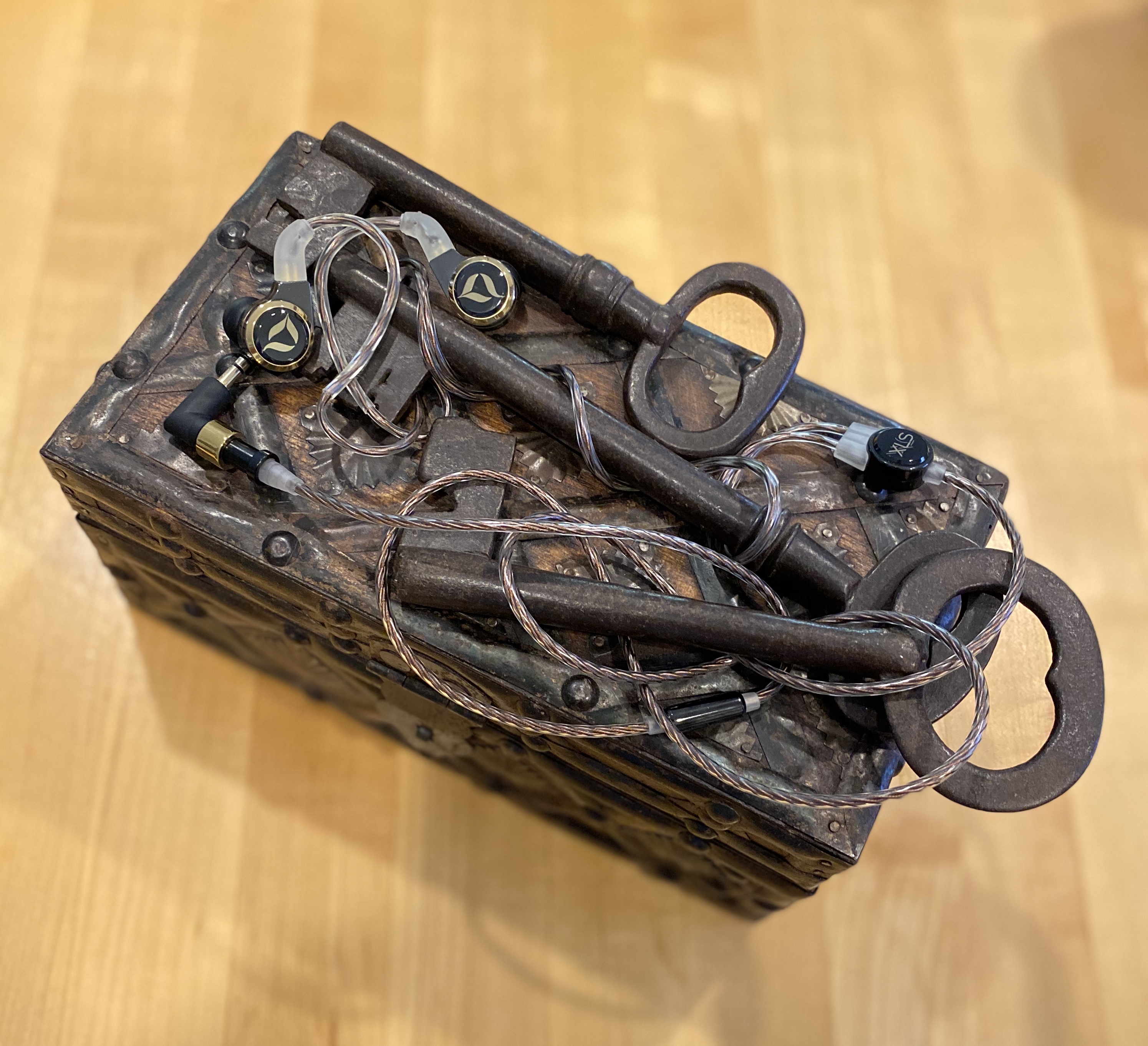
DITA Audio Dream XLS IEM Review
DITA Audio initially captured my curiosity years ago when they released their Answer (Truth Edition) in ear monitor (IEM). It was my first gamble into the world of high end IEMs and it turned out to be a winning decision. DITA Audio is a Singaporean company that takes pride in creating well-constructed products to create a sublime experience for their customers. I would agree with that too. I was astonished by the sound of the Answer (Truth Edition) and how it captured hidden details in my music but left its soul intact. I had found iem’s that not only produced great sound, but also utilized impressive materials in their construction too. This became my new standard in personal audio. When DITA Audio announced their latest flagship, the Dream XLS IEMs, I could not help but be curious about what they may sound like. The moment I received them, I could not wait to sit down in my listening chair, cue up my favorite music and discover whether the Dream XLS were worthy successors to their first flagship or not.

When you first open the package, you will immediately know that you have something special gazing back at you. You are warmly greeted with a letter written and signed by the co-creators Danny and Desmond of DITA Audio. DITA has thoughtfully included two well-constructed leather carrying cases; one soft and one hard shell. In hand, the IEMs are well weighted and demand that you take a closer look. Displaying an obsidian black and gold mirror finish and milled out of a solid block of titanium, the Dream XLSs are striking to behold. As I uncurled the OSLO-XLS cable (that comes standard with these IEMs) I could not contain my excitement to hear how it will extract the most out of the new DITA Ultra-linear (Gen. XLS) Dynamic Drivers! This cable is made from extruded PC Triple-C copper which is soaked in a squalene suspension of gold and silver nanoparticles! I had yet to experience the sound coming from a cable that contains copper, gold and silver, I think it is the first of its kind?! Adding to the excitement was the fact that you are getting three cables in one via the Awesome Plug which can be terminated in a 4.4mm TRRRS, 2.5mm TRRS, or 3.5mm TRS plugs.


My earliest experiences with headphones were with those that solely incorporated dynamic drivers (DD) so I have become intimately familiar with the sound of DD equipped headphones. The Dream XLSs utilize an inhouse sourced composite diaphragm dynamic driver. Now the greatest standout for me with the Dream XLSs is the upper mid and treble refinement. After living with the Answer (Truth Edition) for years (and the original Dream IEMs for a week), I feel that the treble is what has seen the most refinement. Saying this however, does not minimize the level of authority and sophistication of the midrange and bass that DITA previously developed with the Answer (Truth Edition).
Upon early listening the treble presentation of the Dream XLSs initially seemed upfront. However, after some continued listening, I experienced a treble that offers nuance with ethereal qualities. During poorly mastered or early recordings, the treble is quite honest and forthcoming, dry even. With high resolution tracks one can be completely enveloped in gobs of detail without stridency. No easy feat by any means. Inner details are lay bare without being fatiguing. This type of treble presentation definitely lends itself to the wide soundstage and pin point imaging that is experienced here too. I must say that while watching movies on my iPad with the Chord Mojo handling the audio hand-off, the level of immersion due to the detailed and holographic qualities of the XLS’s was absolutely spellbinding.
When evaluating the midrange I first look to be sure that it isn’t colored. I require that the human voice, piano, and wooden instruments sound correct. The XLSs do this with authority and nuance! Male vocals do not sound boxy or without gravitas. Female vocals soar without any piercing sibilance or sounding thin. Acoustical pieces are brought to life with vibrancy as each note materializes from the blackest background. The XLSs have this soft “W” sound if you will. I found that this allows for a wide soundfield to be enjoyed while being anchored most thoughtfully by a speedy but well weighted bass region. I must say without reservation that the mids are sweet while being uncolored here. They are undoubtedly the star of the show, the XLS’s soul if you will.

I have always anticipated a healthy low end from DD based IEMs heavy handed even. What I am hoping to experience is a bass response that goes low with convincing pace, rhythm, and timing (PRaT). I am a “bass-head” in the sense that I crave a speedy authoritative bass without bleeding into the lower mids; not a bass that is overwhelming, goopy, or one note in its attack. I am happy to report that the bass I’m hearing from the XLSs is that of emotive mastery and executed like a delicate dance flowing with precision and nuance. It has speed with a quick leading edge that doesn’t over stay its welcome by presenting with natural decay and no bloat. It draws you in but doesn’t overwhelm. The sub-bass has the body and weight necessary to promote realism to the experience but most importantly the depth too. As demonstrated in the other sound frequencies, the bass is fleshed out but not domineering exhibiting another deft accomplishment here.

Overall the XLSs provide you with a truly balanced sound with effortless fluidity. One that presents you with an ethereal treble range, mids that evoke raw emotion, and lows that are detailed and representative of the music’s underlying foundation. The build quality instills pride of ownership and the accessories are also well thought out. These iems are telling of the source and amplification gear used in the chain and thus scale well in that regard too. For me these iems present a great value with all things considered and are sure to provide you with years of audio nirvana. I’m sure DITA is quite proud of their latest and in my opinion best effort yet.
Last edited:
mungster
Finally someone agrees with me that these iems are great. Love them!
Pros: Wonderful packaging and presentation. Good comfort. Soundstage depth, imaging and macro detail.
Cons: Micro detail lacking versus other, cheaper IEMs. Easily scratched.
I remember meeting Danny and Dennis from DITA Audio back in 2011 or so at the Tokyo FUJIYAAVIC headphone festival, and listening to a prototype of what would eventually become The Answer IEMs. I was very impressed by their attitude, approach and enthusiasm for IEMs. I reviewed The Answer Truth Edition with its permanently attached Van Den Hul cable not long after.
Since then, I'd missed their newer IEMs, but after a presentation in Japan last year by their distributor, S'NEXT (also the manufacturer of the Final brand of headphones and IEMs) I agreed to review a pair of the Dream XLS.
A culmination of all that they have done, the XLS in the name stands for "(e)Xtra Large Soundstage". Presented in a fantastic box with a number of accessories, including a unique set of stickers that convey technical aspects of the design, they very much look the part.
Design-wise, they have a thicker version of the round pill-shape that is standard with their models. The nozzle, thankfully, extends a bit further than the one on The Answer, helping with getting a good seal.
Here's the unboxing video if you want to see everything that is included:
DITA's new Oslo cable is included with the Dream XLS. Using a copper-in-oil set-up, like very old-style cables, I was impressed how it improved the sound with a pair of Campfire Audio Solaris when I tried it briefly at one of the Tokyo shows. With removable plugs at the source end, it can be configured quickly to 4.4mm, 3.5mm or 2.5mm connections by unscrewing the collet and pulling the plug off.
For the Dream XLS, it uses a 2-pin set-up which firmly attaches to the IEMs, requiring sufficient force to remove that I don't see the IEMs falling off easily and being lost. The cable is quiet, not transmitting contact noise to the IEMs. That meant, overall, that with the cable around one's ears, ergonomics, at least for me, were pretty good.
Listening
Like the The Answer, the Dream XLS is somewhat tuneable via tip selection. Included are Final Type E tips which, being narrow bore, keep the sound towards the warmer end of what is possible.
With the Type E tips on, the sound is somewhat on the lighter side of things, with the excellent bass intruding only when it is significantly present, and never overing itself. Mid-range and sound stage I found to be great, with a good sense of depth and presentation of instruments.
The treble was best after a few days of run-in, being about right on a lot of acoustic music, but the lighter sound signature being a bit bright for more modern, more brightly mastered music.
While the Dream XLS had a very good sense of depth, and good imaging, I wasn't hearing the "eXtra Large Soundstage" that the name suggested they have. Switching to wider bore tips, such as the JVC Spiral Dot tips, the result was only that the sound became too light, with too little bass, and no improvement in sound stage.
Select Music Impressions
I had on hand a bunch of IEMs with which I could compare, including the Fearless Dawn, Final A8000, Campfire Audio Andromeda MW10, HiFiMan RE2000 and Dunu Luna. I took notes about how a number of tracks sounded on each. I used the Chord Hugo 2 and Cayin N6ii (E02) for listening.
They are written "Artist - Album" with the track included if relevant.
SEED Ensemble - Driftglass
Funnily enough, I discovered this album when discussing the effects of MQA encoding on music. The Dream XLS (with stock narrow-bore tips) produced a greater sense of depth than the A8000, which tends to sound wide, rather than deep, and is a bit too bright. Sharp percussion and beautiful bass rumble, but the soundstage was not "eXtra Large" compared to the others.
The slightly muted treble of the DUNU Luna, on the other hand, seems to mute the impact of drums slightly. The RE2000 has a treble that is too tizzy for this album.
Merge of Equals - Intoxicating
Roon Radio served this up for me, and I'm glad it did. As I sometimes like to delve into Cafe del Mar compilations, this is along those lines. With the exception of the MW10, which is warmer-sounding, most of the IEMs I had on hand tended to be a bit bright and treble-fatiguing. The Fearless Dawn, after the treble had settled down, fills out the bass nicely with plenty of warmth, and the Dunu Luna's slightly muted treble avoided discomfort here, unlike the A8000 which, as usual, was too bright (though some people might like that). To that, the Dream XLS had nothing particular to show, my notes saying "unremarkable".
Miles Davis - Doo Bop - Mystery
Not a high-quality recording, but great jazz all the same. Funnily enough the DITA, not being so bass-strong, is not a good tonal match, but that I put down to the weird mastering of this track, with a lot of bass. The winner for this oddly-mastered, bass-strong track was the Andromeda MW10, with it's glorious mid-range, that made the trumpet sound awesome.
Marc Ribot - Marc Ribot y los Cubanos Postizos - Aurora
Let's talk high-quality latin guitar. The DITA here shined with nice dynamics on notes and good instrument separation, but compared to the Fearless Dawn, A8000 and Andromeda MW10, note nuances (detail) were not as discernible.
The Andromeda MW10 made each note an event, even if the thicker sound wasn't a perfect match. Think old-school JBL speaker-like presentation. The Fearless Dawn's intense, v-shaped presentation brought out the guitar just perfectly. The Final A8000 had remarkable instrument separation, with notes almost floating out of the space they are in.
Jazz in the New Harmonic - Primal Scream - Quiet Desperation
This, very high quality album of dark jazz is most remarkable out of a high-end system. I honestly think to "get" this album requires top-of-the-line equipment, such is the level of nuance audible from each, individual note. This is where the Dream XLS most disappointed me, as those subtle nuances, that make up the expression of the artists, just weren't there. The details of the decay of cymbal hits, for example, and the echos of the sound across the recording space, were just lost. Even if it has good imagining, the lack of those subtleties muted the enjoyment of that. While not as nuanced as the Final A8000, the Fearless Dawn was a step above in detail over the Dream XLS, even if it tends to have a quite aggressive, forward mid-range and treble and strong bass. Since the albums from David Chesky tend to be recorded/mastered with quite a bit of bass, and none of the over-blown treble of a lot of recent music, it matched up beautifully with the Final A8000, even if the soundstage was lacking in depth to some degree. The Andromeda MW10 was my favourite here. Despite having a thicker sound that seems initially to be less nuanced (less treble tends to give that illusion) the slightly bloomy mid-range is very satisfying, and the treble quality outstanding, with excellent overall speed.
Conclusion

After I posted my video review of the Dream XLS, one viewer commented on how happy they were with their purchase.
From my perspective, the Dream XLS on its own, has great imaging, and its lighter sound signature and fantastic dynamic-driver bass make it very enjoyable to listen to a lot of music with. However, the lack of micro-detail compared to other, often cheaper IEMs, as well as the inability to tune the IEMs with wider-bore tips without losing too much of the already-restrained bass, makes me feel that the Dream XLS, isn't good value at $2299. Harsh as it is to say it, if DITA had not bothered with the fancy box and stickers, and sold the Dream XLS at $999, I reckon they would have a winner.I disagree with this review. I bought the dreams XLS about 2 months ago, paired it with Astell & Kern SP2000 copper version. I listen to mostly atmospheric post rock such as Alcest, progressive metal/ rock such as Opeth and Orphaned land, etc. The dreams XLS sounds very natural and musical, the instruments layering and positioning are very accurate, almost 3D like, which is unmatched by other “ Top of the line” IEMs. I have compared them to Fir M5, 64 audio tia trio, 64 audio Nio, campfire audio andromeda, Solaris, beyerdynamic t9ie, Noble sultan, final A8000, and even the Sony Z1r, none has that kind of 3D layerings and transparent qualities. The acoustic guitars especially sound magical on these, and the high notes feel airy and transparent. They do really well when the music has a lot of different instruments going on. Try to listen to the intro and vocals on Opeth’s songs “Burden”, “Face of Melinda”, “isolation years”, you’ll notice that. And the best thing is they are not fatiguing even after hours of listening. That being said, these pair need at least 200 hours burn in time
Attachments
IgeNeLL
I have audited it and base on my experience it is a little disappointing to the hyped review over the forum.
The sound signature is mid centric lack of both top&bottom end extension.
The mid-range signature is thick, lack clarity and detail.
The stock cable is not good.
The sound signature is mid centric lack of both top&bottom end extension.
The mid-range signature is thick, lack clarity and detail.
The stock cable is not good.
yong_shun
1000+ Head-Fier
Pros: »Neutral and balanced sound signature
»Excellent build quality
»Accurate and precise bass response
»Uncolored and natural midrange for vocal monitoring
»High quality stock cable
»Smooth and well extended highs
»Tons of useful accessories
»Awesome plug implementation to make stock cable usable for various DAPs
»Huge soundstage
»Excellent build quality
»Accurate and precise bass response
»Uncolored and natural midrange for vocal monitoring
»High quality stock cable
»Smooth and well extended highs
»Tons of useful accessories
»Awesome plug implementation to make stock cable usable for various DAPs
»Huge soundstage
Cons: »Might be bright for those who have lower tolerance to treble
»High price
»High price
The Dream XLS is DITA’s new flagship – a cumulation of experience throughout the years from the original Answer to the Dream Gen.1. By applying lessons learnt from the original Dream and with new technology implementation, the Dream XLS can definitely meet your expectation for a flagship model.
Disclaimer
This article is originally posted on Headphonesty. Thank you, Project Perfection Pte Ltd, authorised distributor for DITA Audio for loaning me the Dita Dream XLS in-ear monitors (IEMs). It was loaned to me in exchange for my honest review and opinion. The unit will be returned to Project Perfection after this review.
Introduction
Established in 1971, Packagers Pte. Ltd, parent company of DITA Audio, has 49 years of research and experience in automation and engineering. DITA Audio adopts the experience and methodology from the parent company to build audio products that are supreme in both build and sonic quality. Besides the experience from Packagers, DITA is constantly driving collaboration ventures with potential parties in different sectors – to enhance design, engineering and manufacturing.
In 2015, the Answer was awarded the President’s Design Award for its exemplary quality in build and thoughtful user experience consideration. In Singapore, the President’s Design Award is the highest honor for designs across all design disciplines. The award recognises the outstanding contributions by a group of people that is working hard to yield a difference to the lives of both Singaporeans and people around the world.
DITA Audio did not stop there. With the recognition from fellow Singaporeans, DITA continues their journey to conquer the audiophile communities around the world. With the lesson learnt in designing the first generation of Dream and experiences from various collaboration ventures such as collaborating with the venerable Dutch cable company, Van Den Hul, DITA launched their latest Flagship, Dream XLS to update their current lineup.
From sound signature to design and appearance, every facet of the Dream XLS is a labor of love and DITA’s endeavour to bring all it knows to your listening sessions. Let’s explore the Dream XLS in this article!
Unboxing
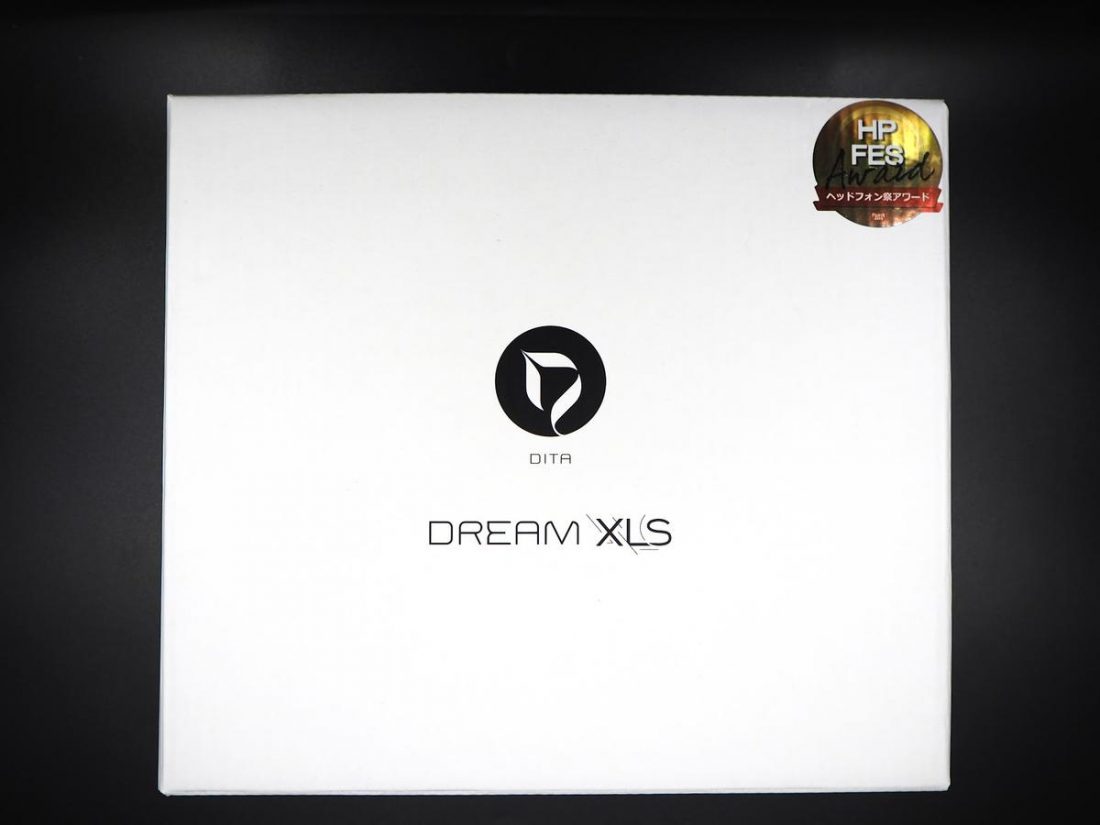
The outer box of DITA Dream XLS
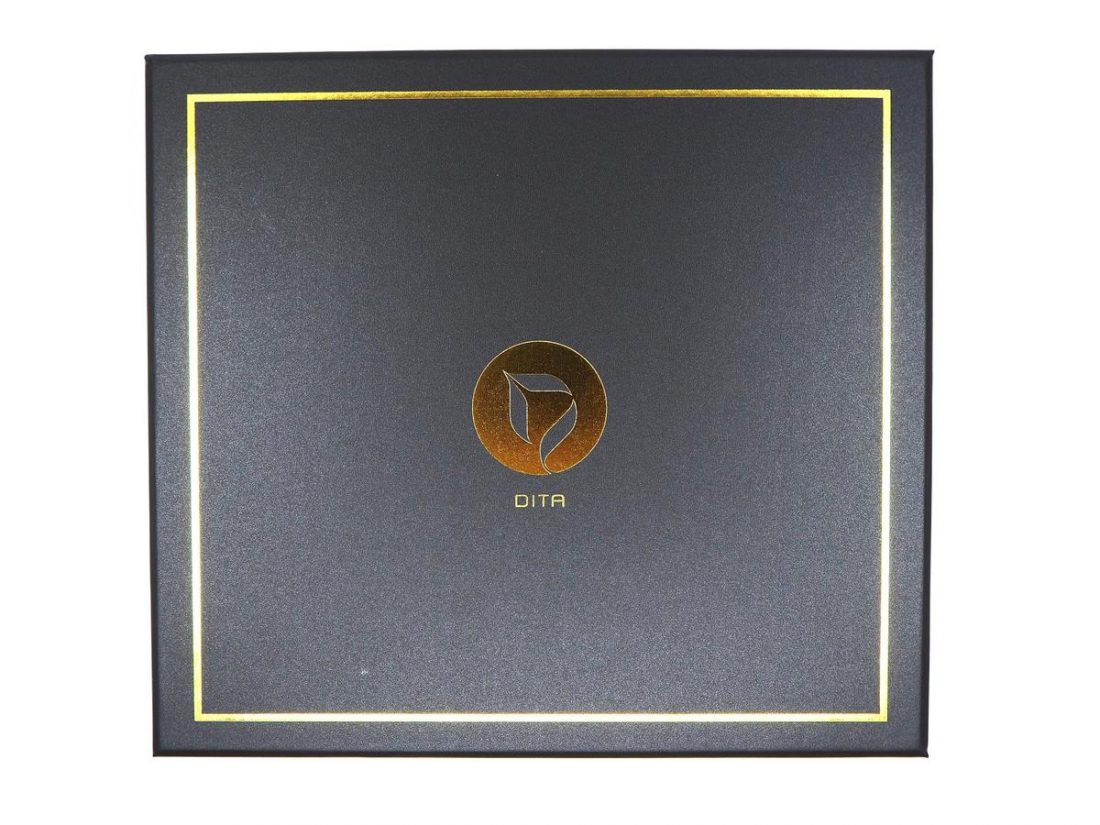
The luxury box with gold and black colour combination
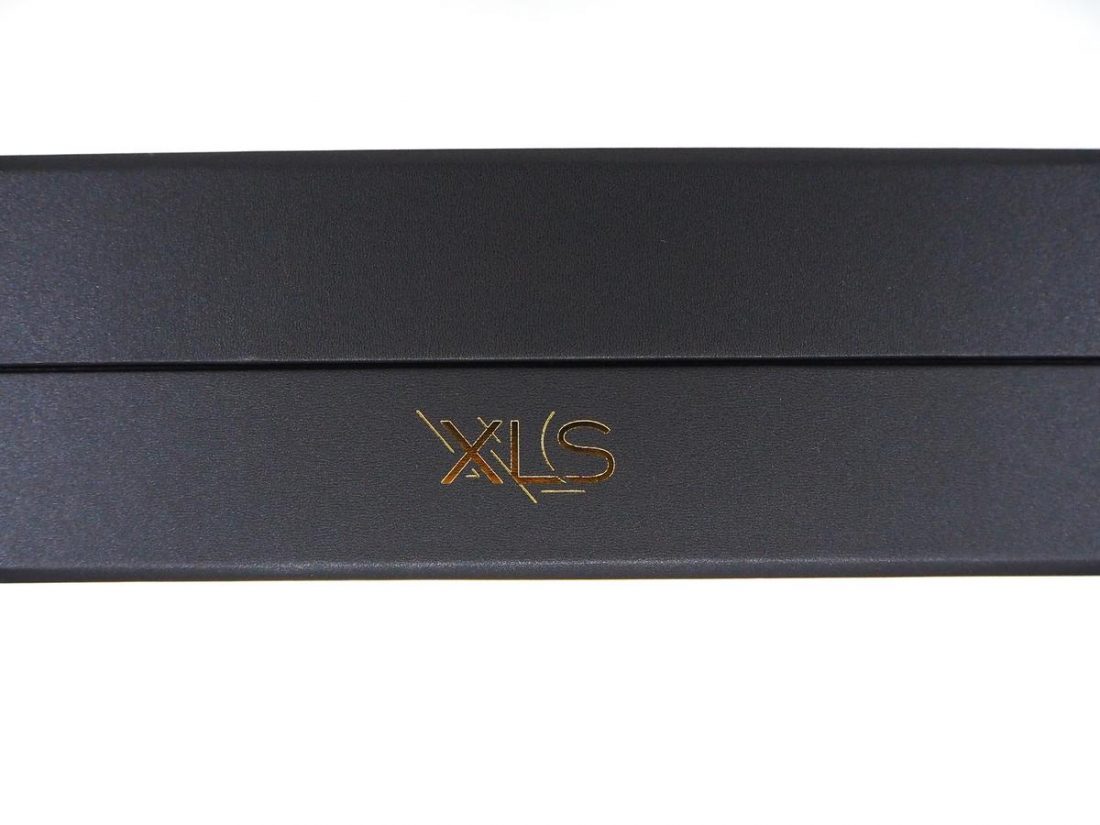
“XLS” on the side of the box
Opening the heavy, luxurious box, the inside is separated into two sections – Dream XLS with cable attached is in the upper section and other accessories such as cases and ear tips occupy the lower section.
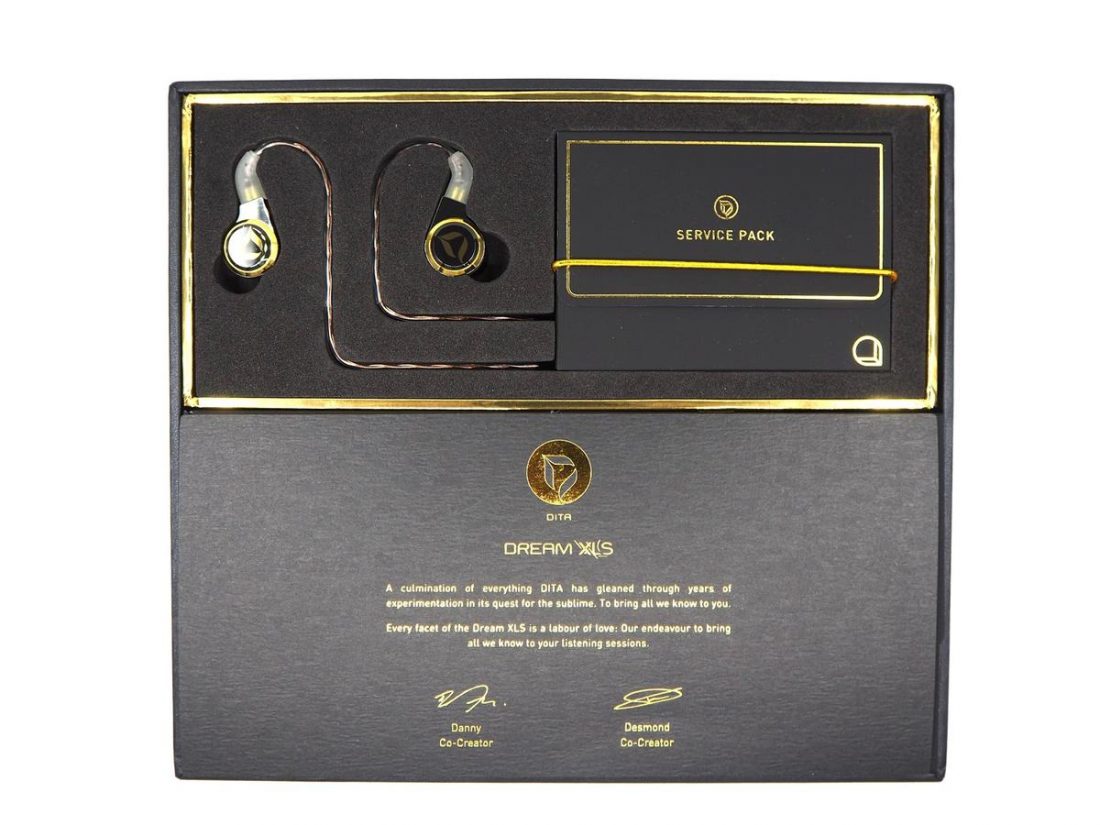
Dream XLS makes its first appearance
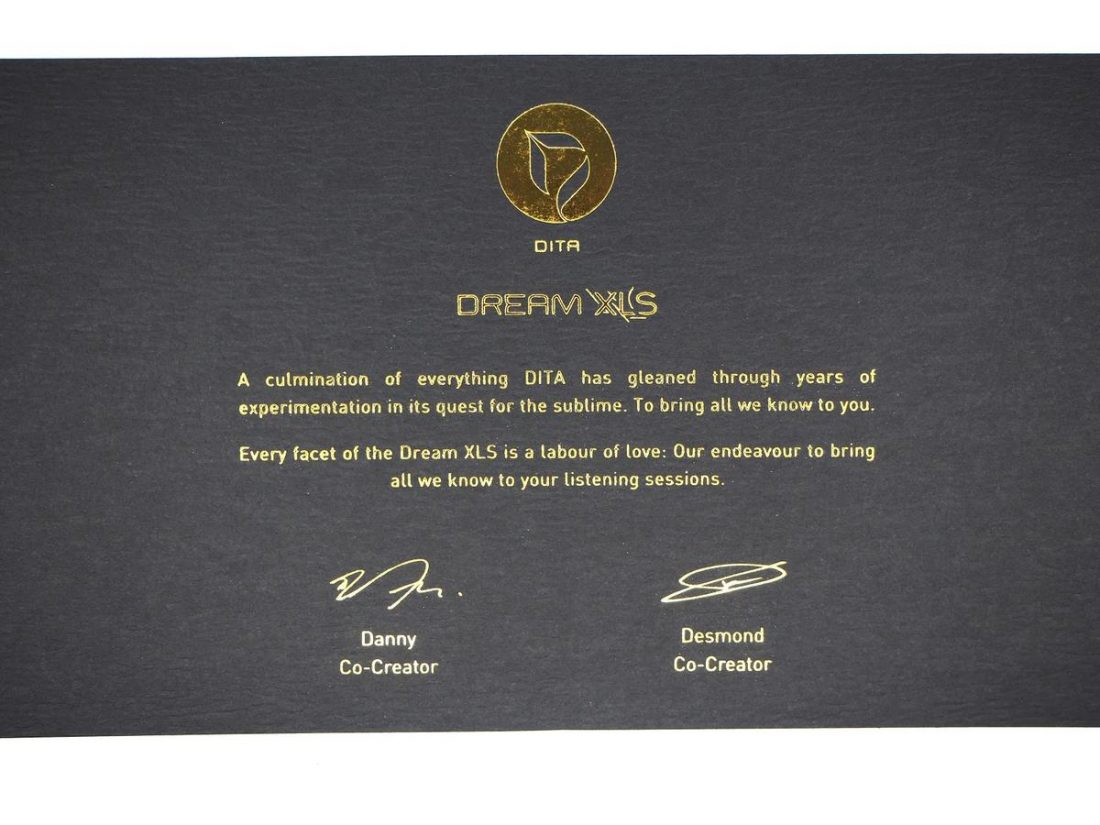
A short notes from co-creators
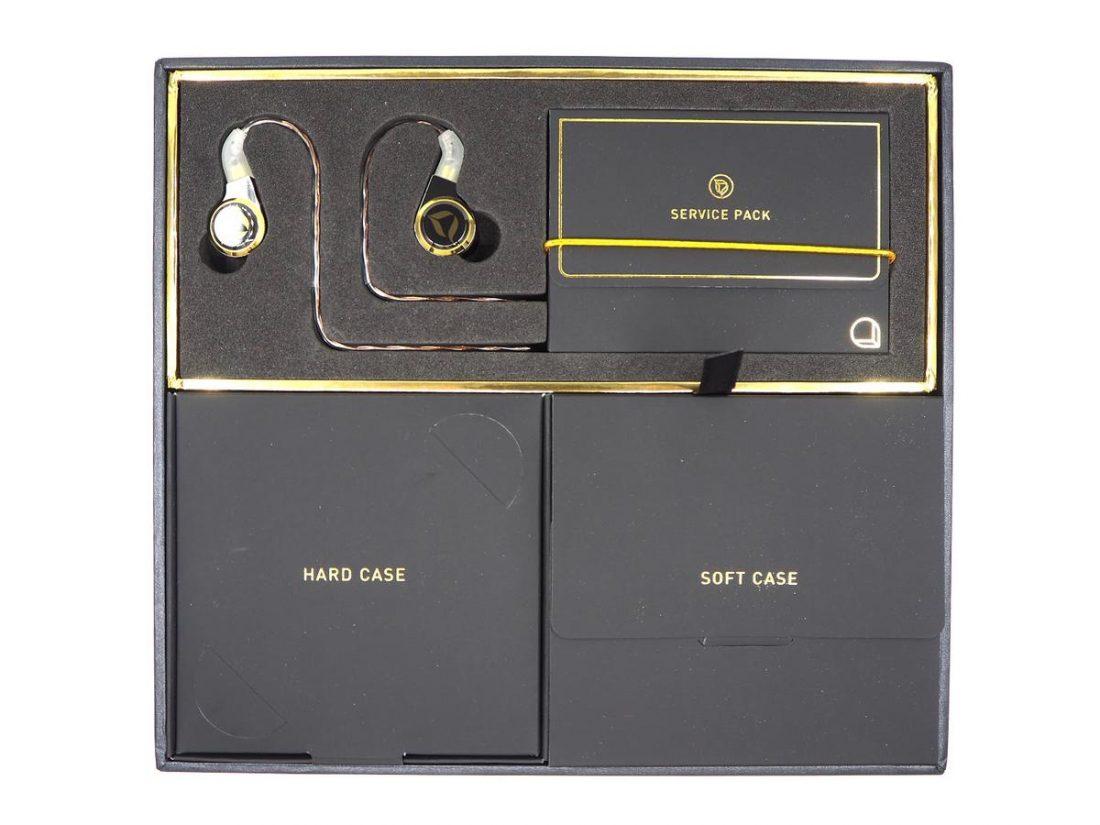
The service pack and Dream XLS occupy the top section of the box while other accessories occupy the remaining half.
Here are the accessories that you can expect in the box:
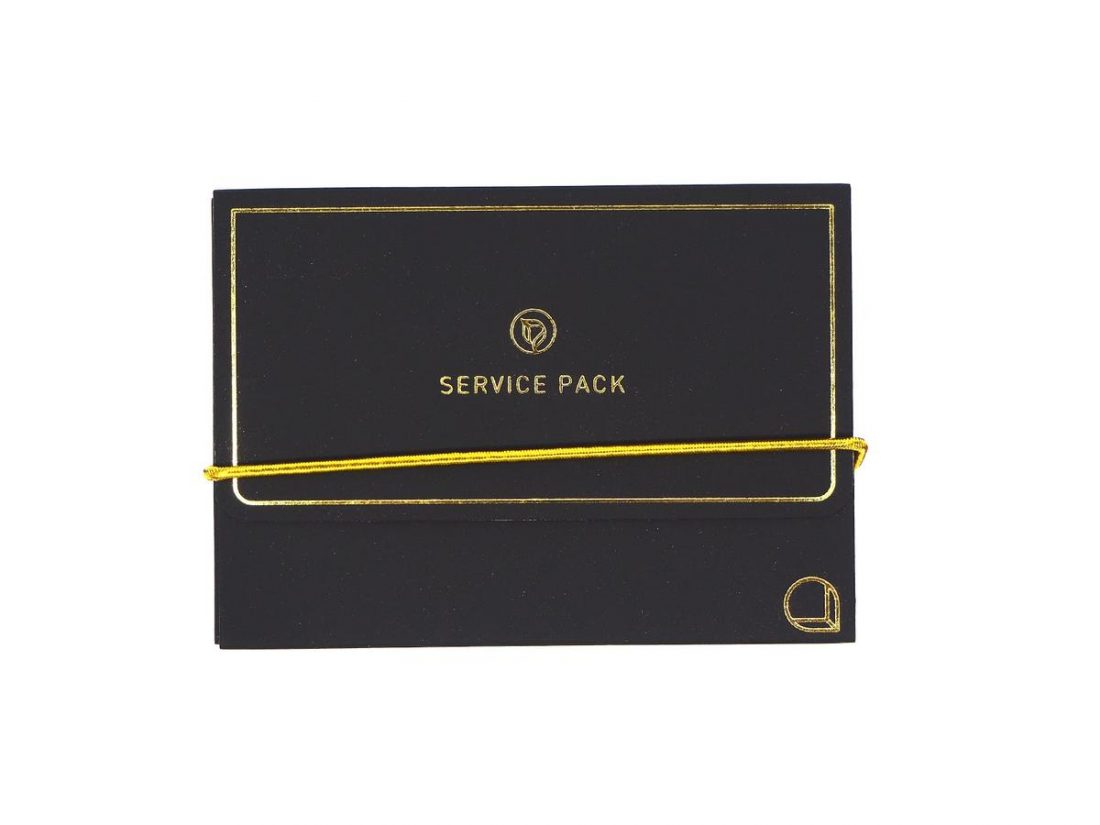
Service Pack
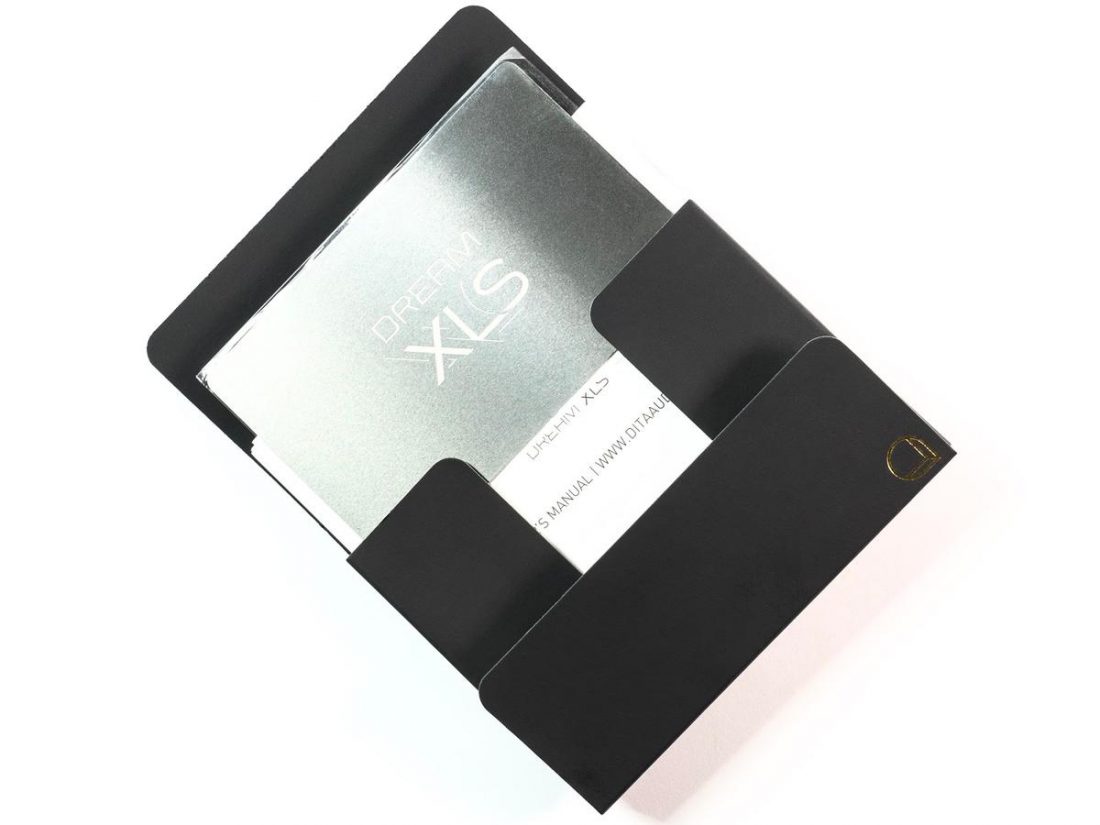 Warranty card and manual are stored in service pack
Warranty card and manual are stored in service pack
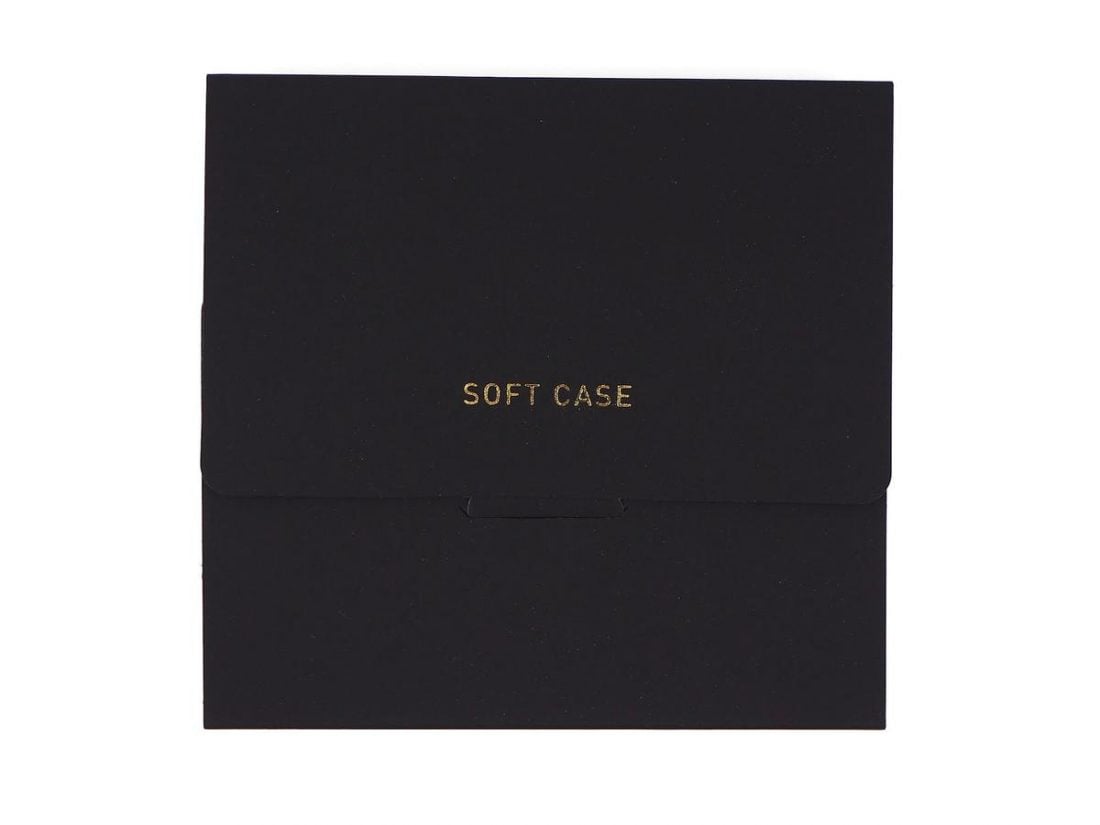
The soft case
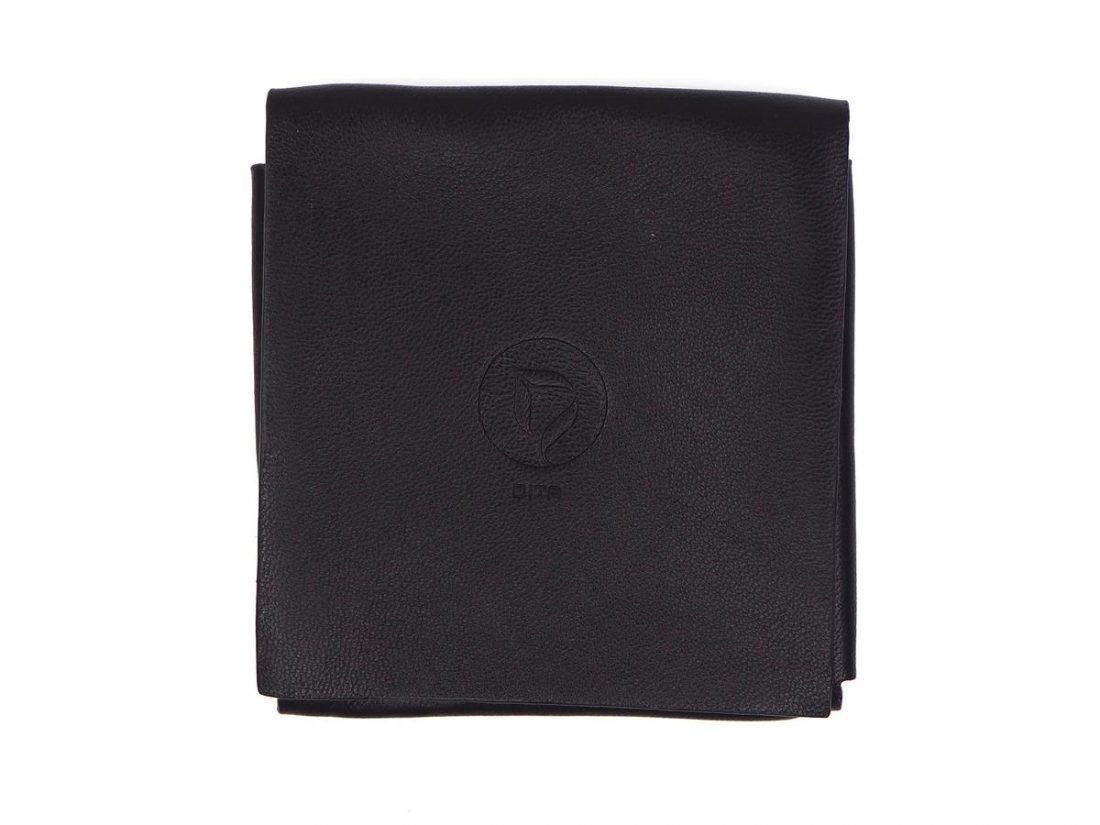
The soft case
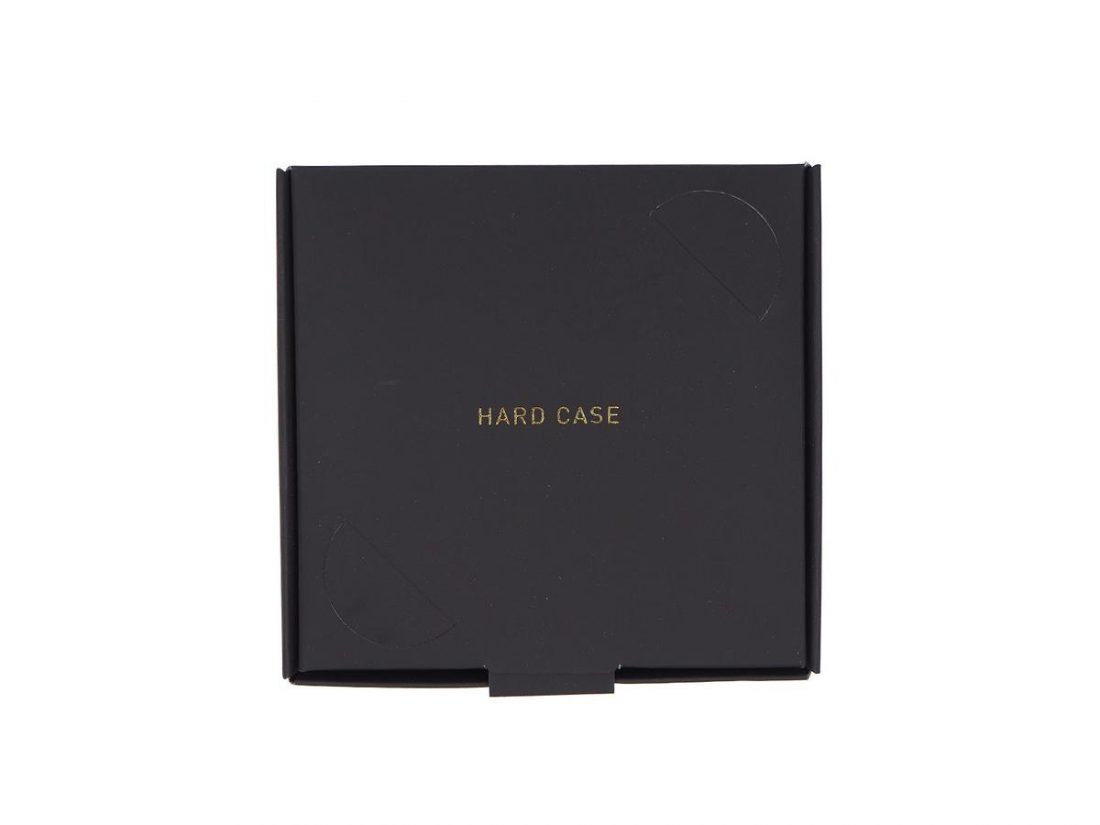
The hard case
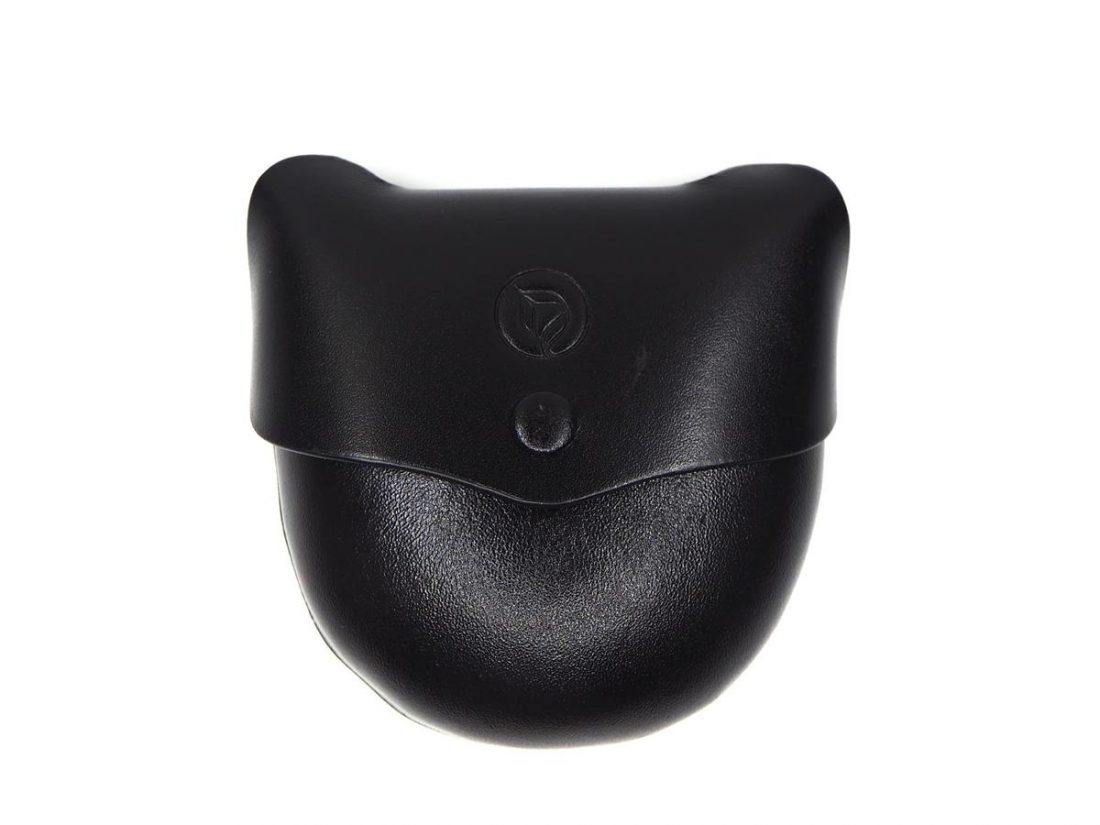
The hard case
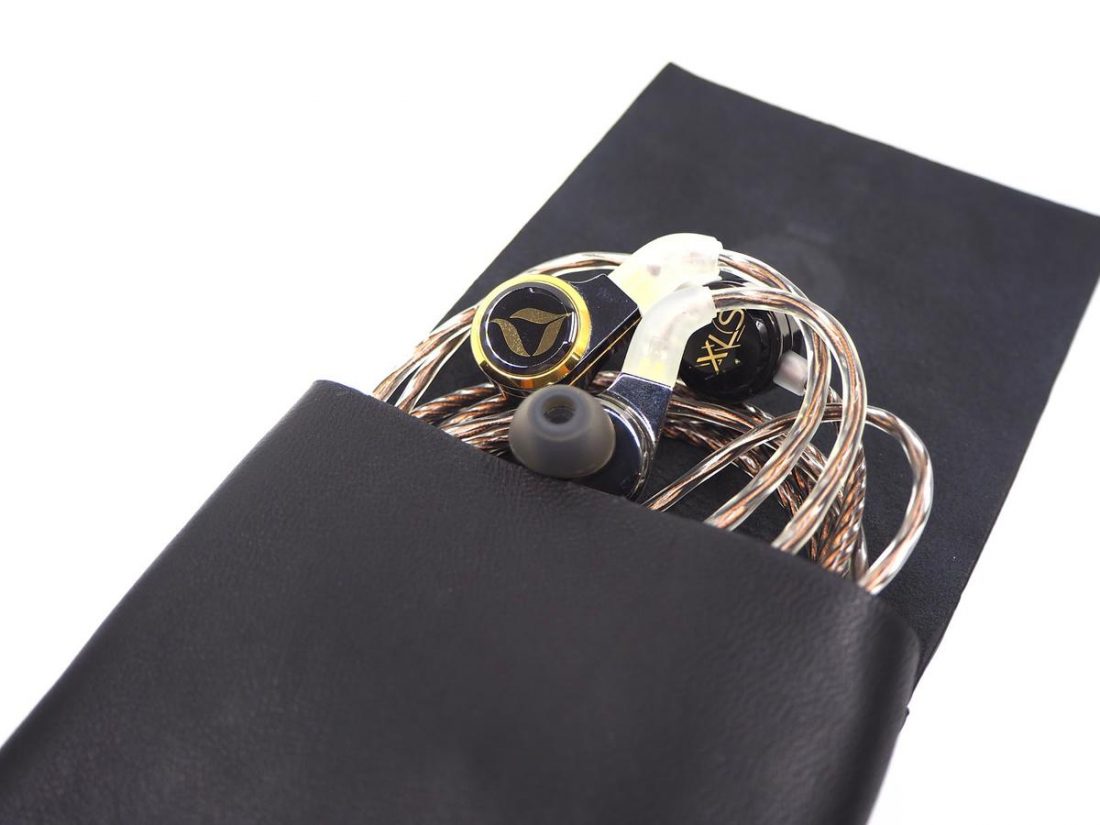
Storing Dream XLS in the soft pouch
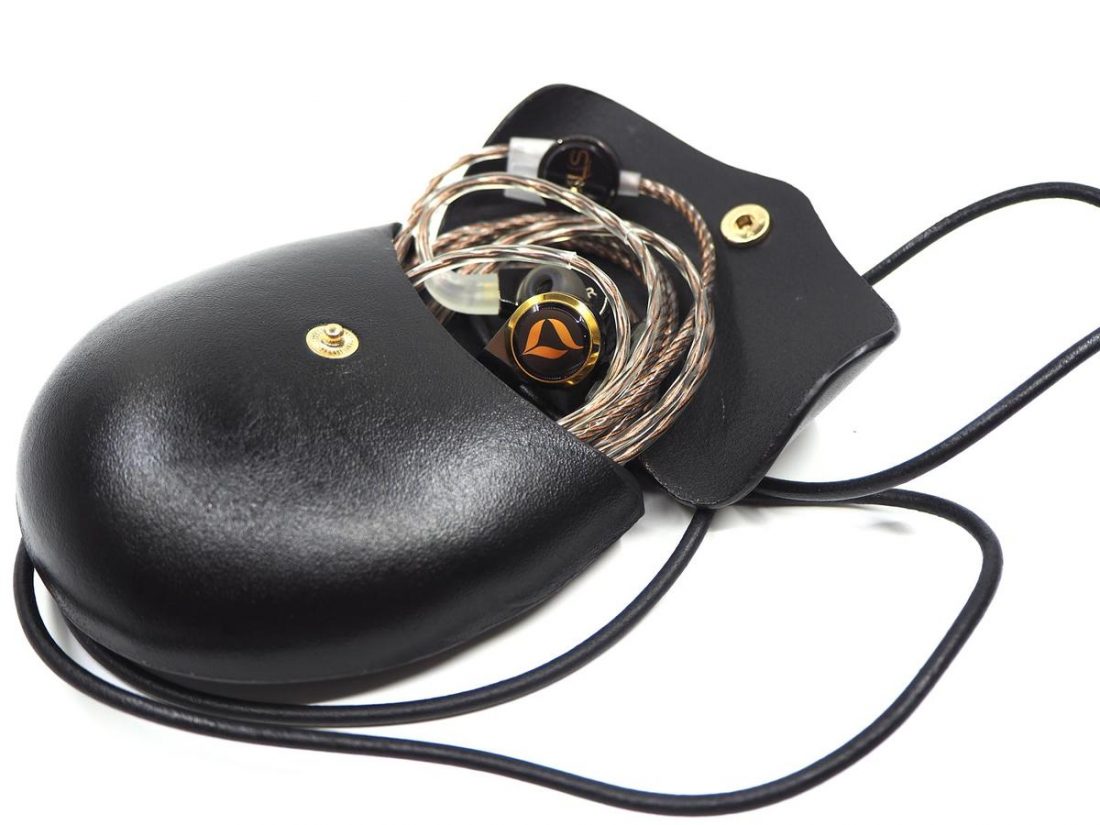
Storing Dream XLS in the hard case
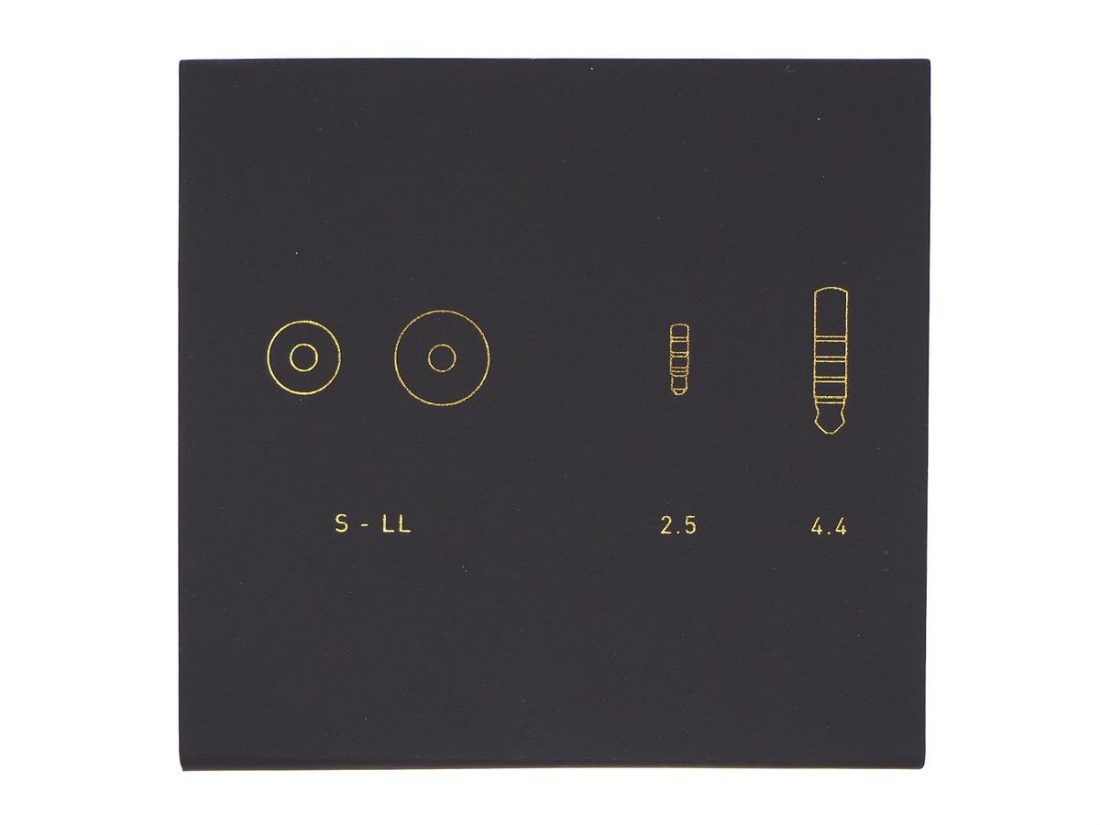
Box for ear tips, awesome plugs, fibre cloth and spare meshes for nozzle
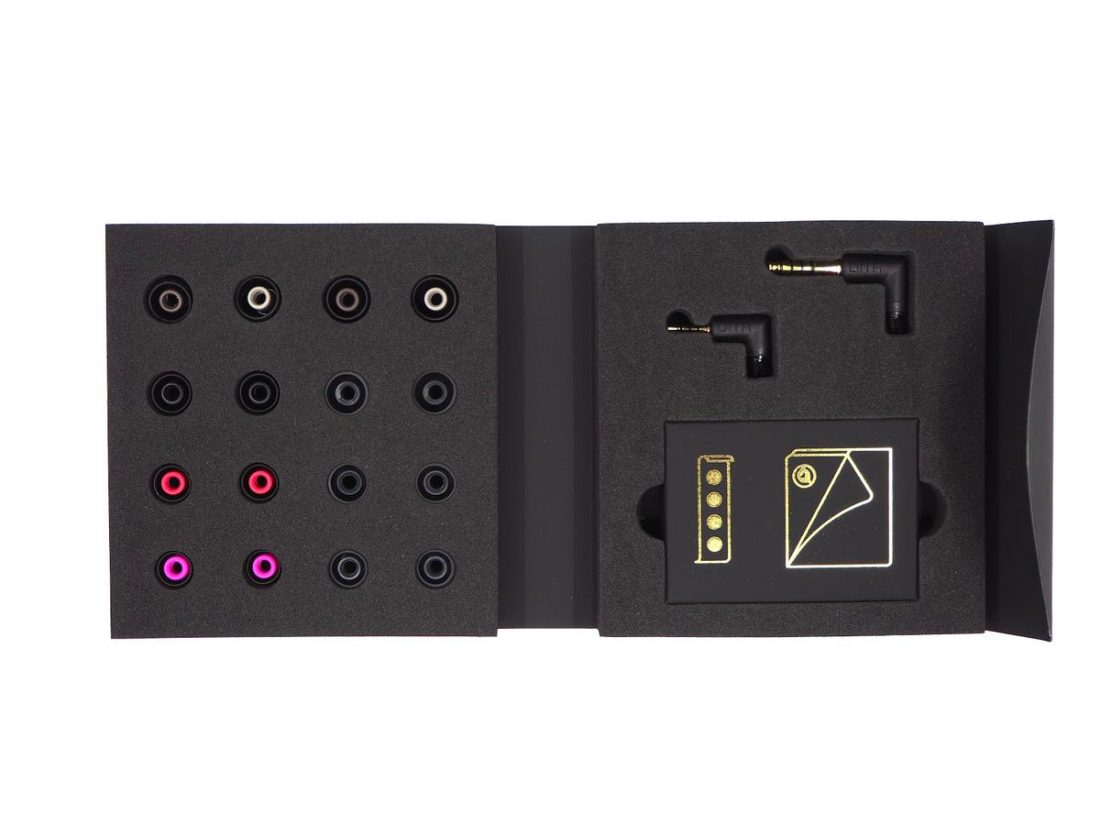
Box for ear tips, awesome plugs, fibre cloth and spare meshes for nozzle
Technical Specification
Chassis
Made entirely in Japan, the Dream XLS has an intricate, computer numerical controlled (CNC)-milled Titanium chassis with sapphire crystal faceplates created specifically for the XLS. For a dream class product, DITA only uses materials that their research deem worthy. For this expression of sound, titanium lends it’s flavor for exceptional smoothness and resolution. The chassis is hand polished to a mirror shine.
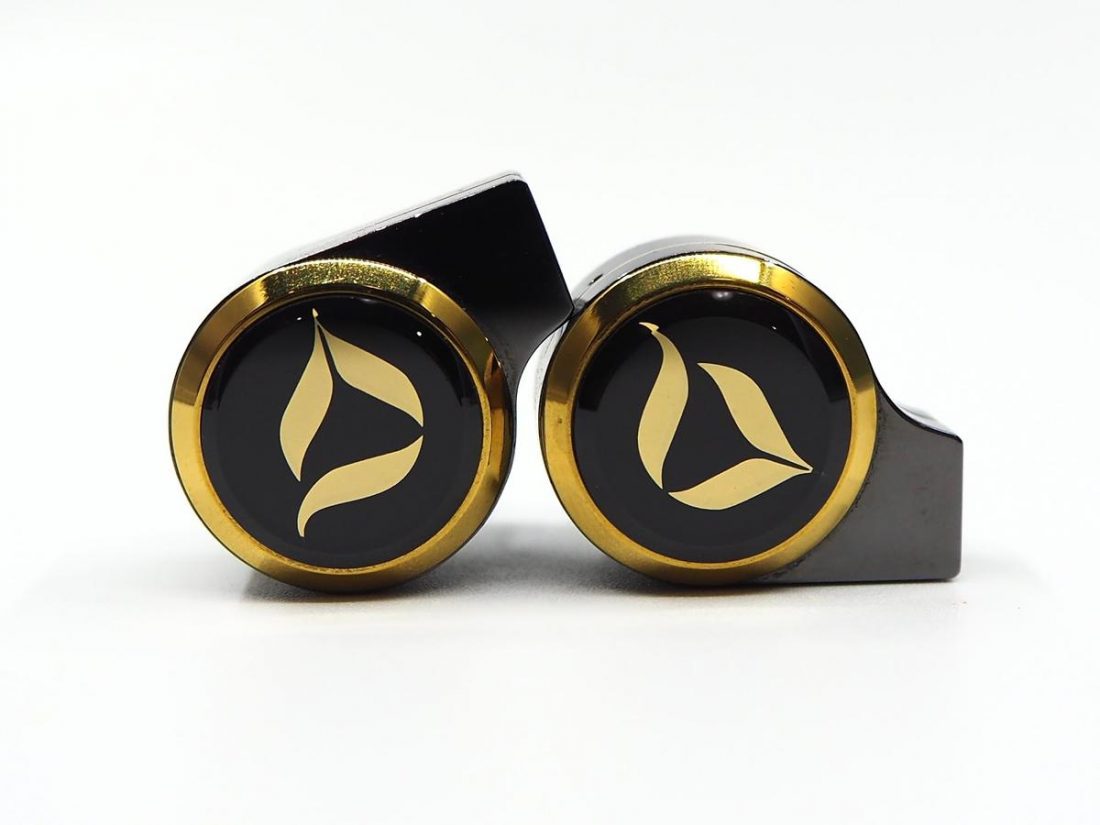 Computer numerical controlled (CNC)-milled Titanium chassis with sapphire crystal faceplate
Computer numerical controlled (CNC)-milled Titanium chassis with sapphire crystal faceplate
The build of Dream XLS is indeed very solid – a smooth surface with the titanium glowing. It immediately shows the flagship characteristic of Dream XLS. On top of the shell, users can find the recessed 2-pin connector. I did some cable rollings and 0.78mm 2-pin cables fit well with Dream XLS.
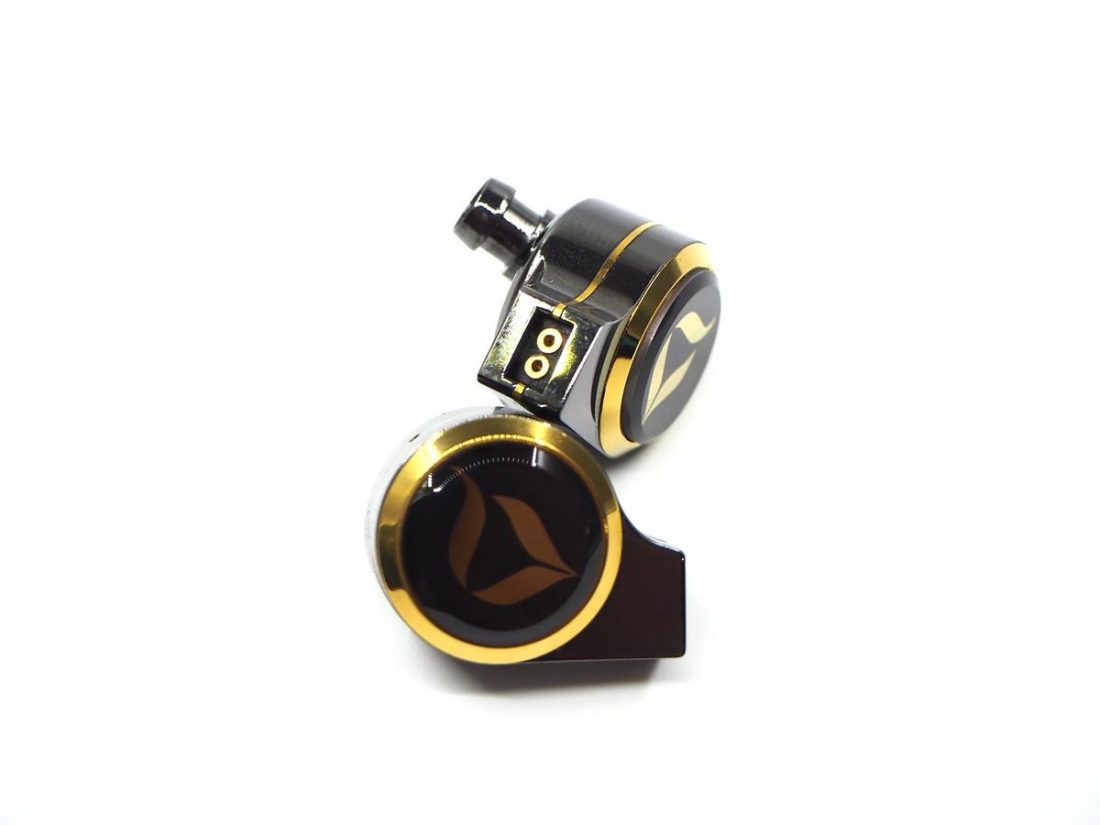
The 2-pin connector on top of the shell
The titanium nozzle is in one piece with the shell. The diameter of the nozzle can be considered averagely wide. Most of my ear tips such as SpinFit CP145 and MandarinES Symbio F can fit the nozzle well. There is a lip on the nozzle to provide a secure catch to the ear tips.
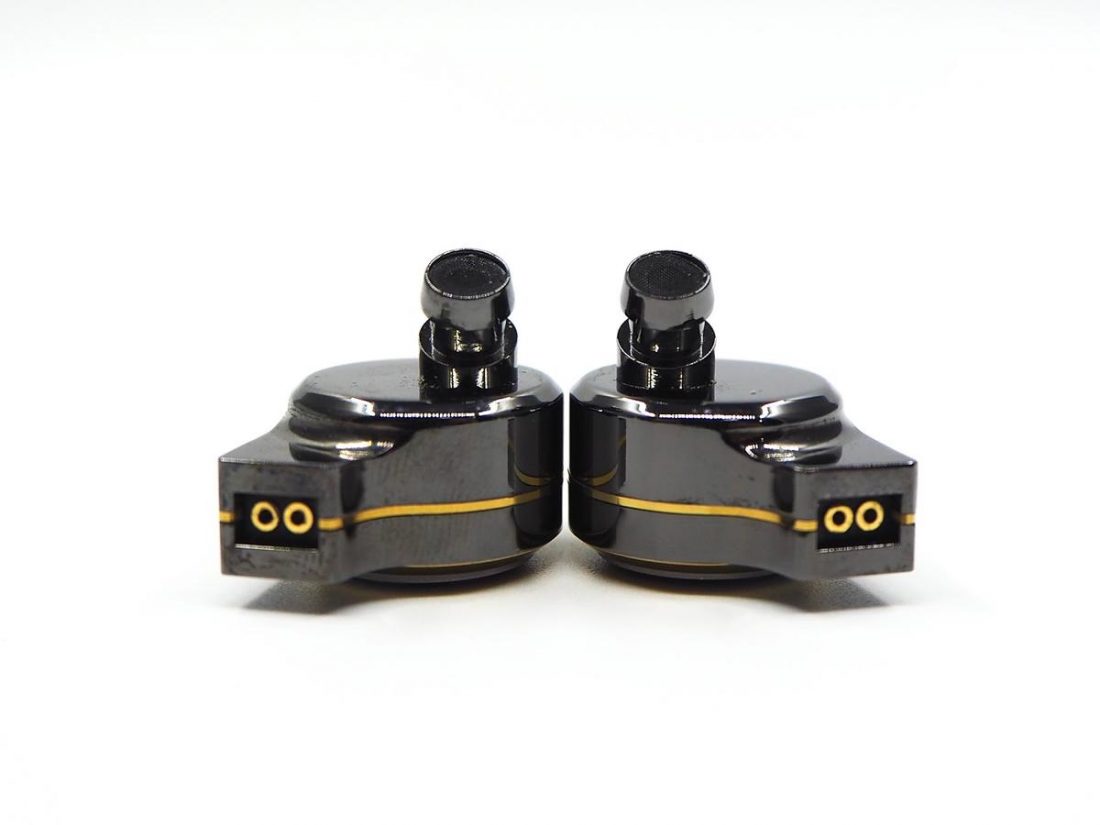
The nozzle of Dream XLS
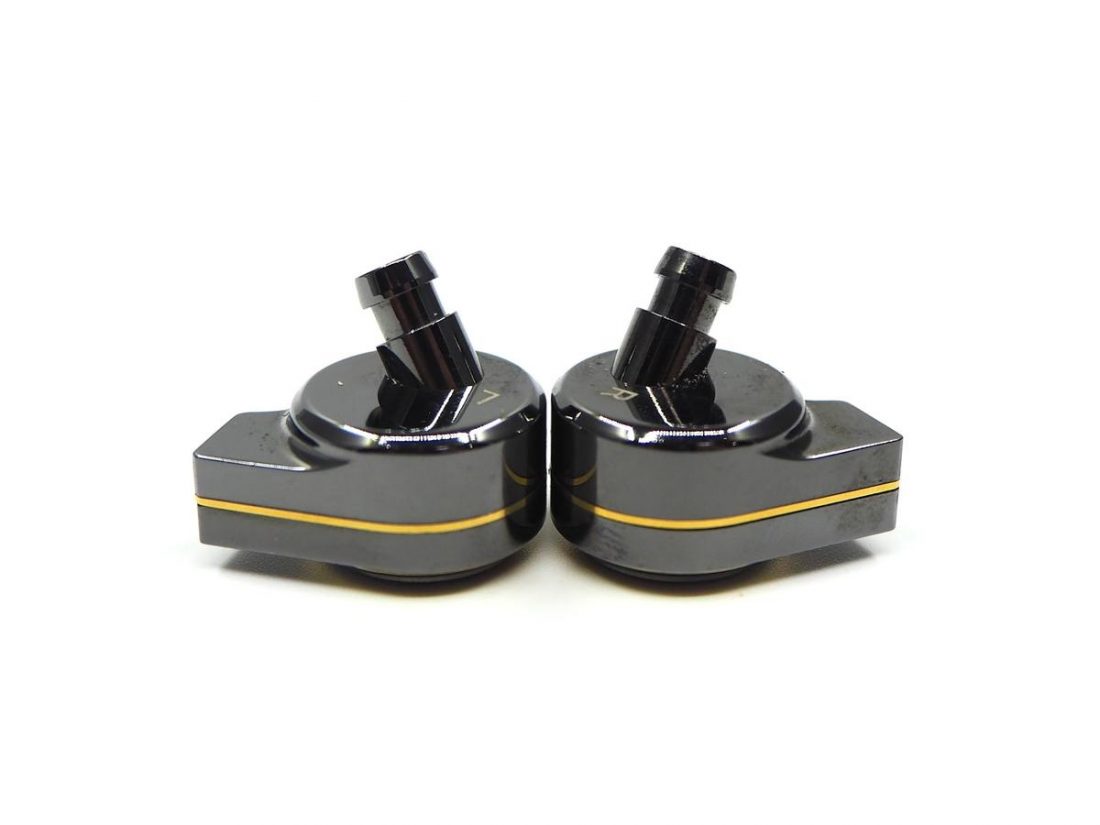
The nozzle of Dream XLS
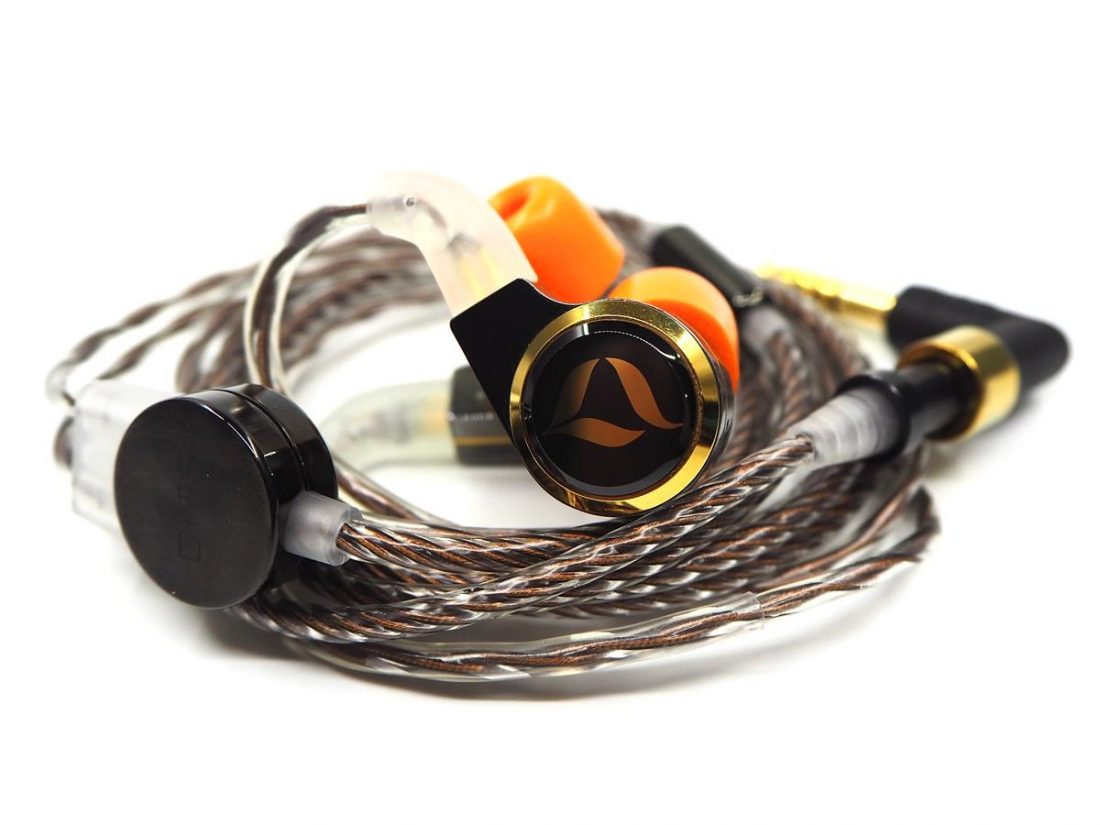
Dream XLS with MandarinES Symbio F ear tips
Dynamic Driver
The Dream XLS features the DITA Ultra-linear composite Dynamic Driver Gen XLS, which is specially designed by DITA for Dream XLS. According to DITA Audio, the improved composite dynamic driver improves resolution, sensitivity and emotional engagement. When the DITA Ultra-linear composite driver is paired with the titanium acoustic chamber, the driver is allowed to utilize the characteristics of titanium; fast, dynamic and control.
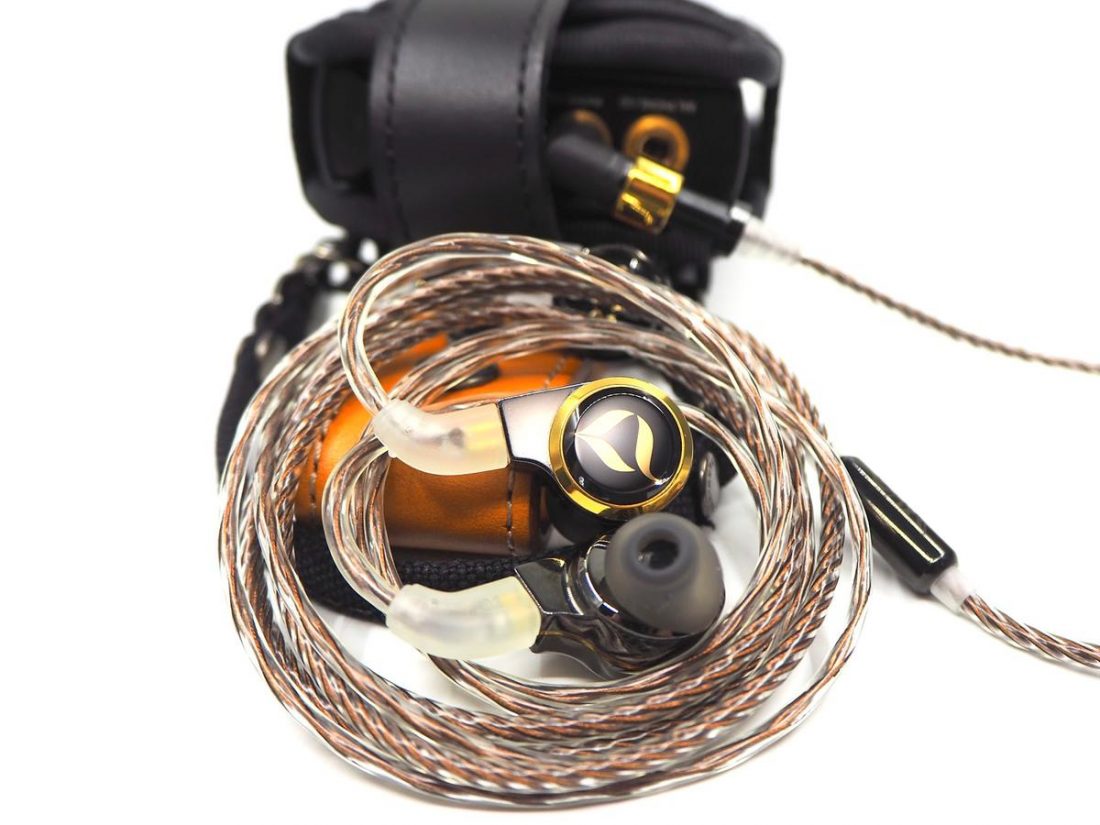
DITA Dream XLS with Van Nuys Case
Cable
An Oil Soaked Long-crystal Oxygen-free for Dream XLS (OSLO-XLS) cable is specially optimized and provided for the Dream XLS. Based on a Pure Copper-Continuous Crystal Construction (PC-Triple C) high purity copper that is extruded and soaked in a squalene suspension of gold and silver nanoparticles, it results in smoothening microscopic surface irregularities and eventually yielding a better contact and smoother signal transfer.
The sleeve of the cable is improved to be smooth and easy to manage. The Dream XLS comes with the full suite of an Awesome Plug to suit your digital audio player (DAP) out of the box.
The Awesome Plug is DITA’s future-proof solution to the traditional earphone plug, allowing the hobbyist to use a multitude of configurations on the plugs end. The plug is interchangeable and available in 2.5mm TRRS, 3.5mm TRS and 4.4mm TRRRS. The 90-degree nature of the plug is kept functional and minimally intrusive when used directly with smart devices.
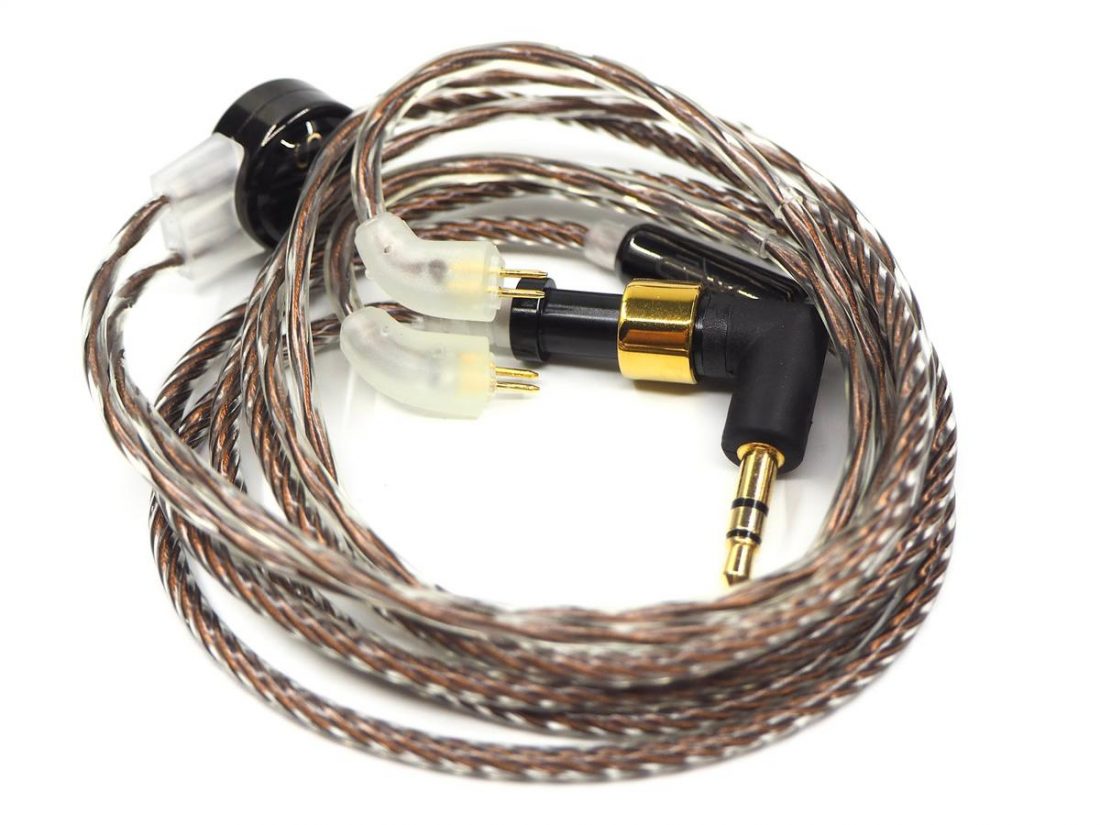
OSLO-XLS
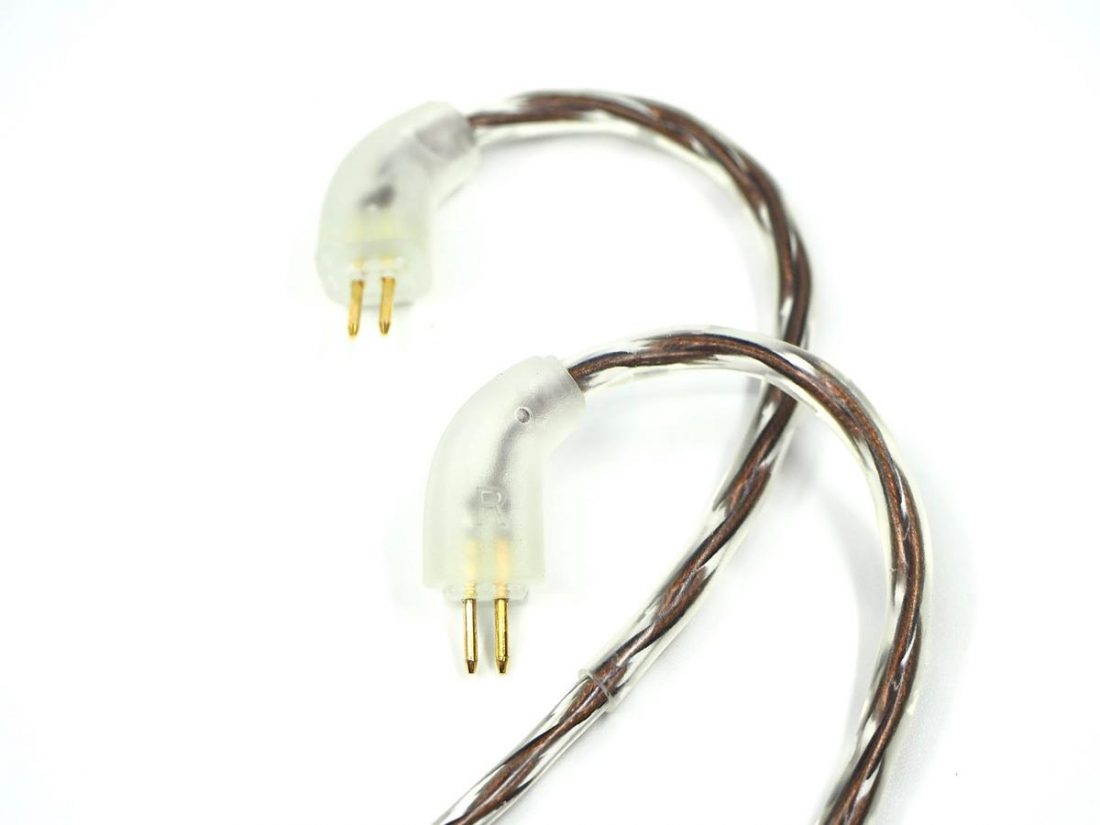
Dream XLS 2-Pin Connector
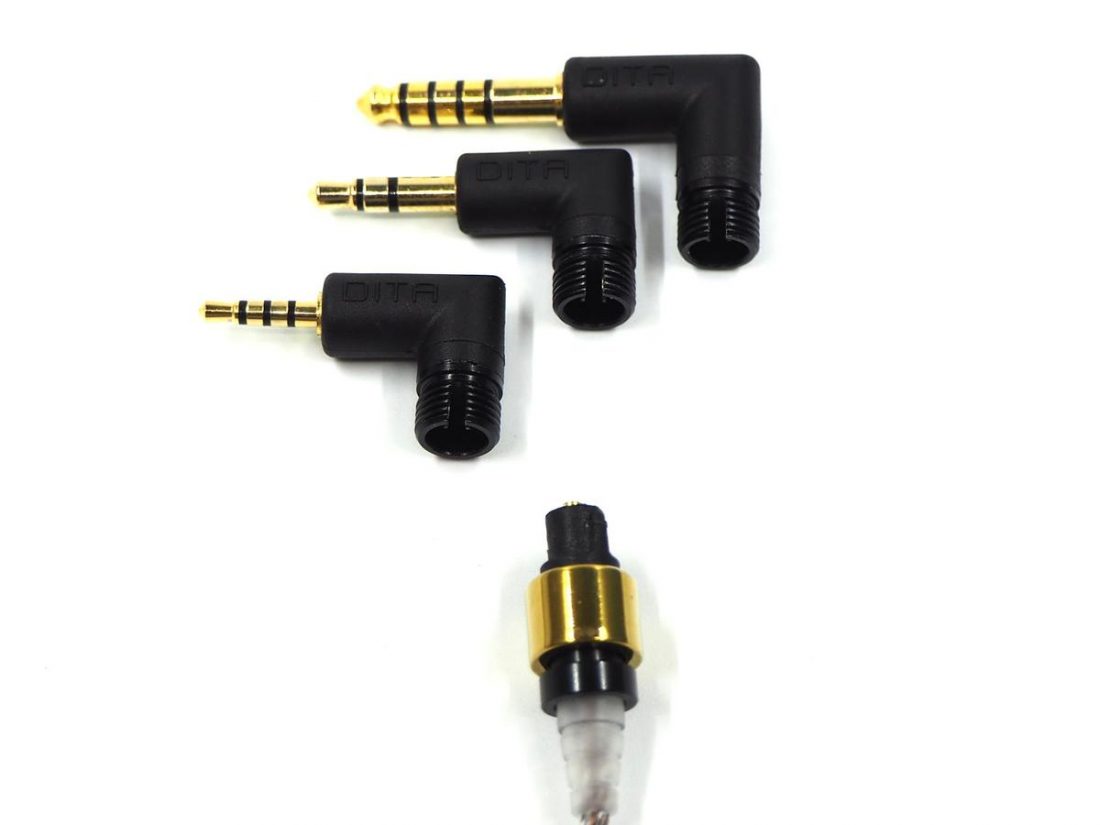
The awesome plug
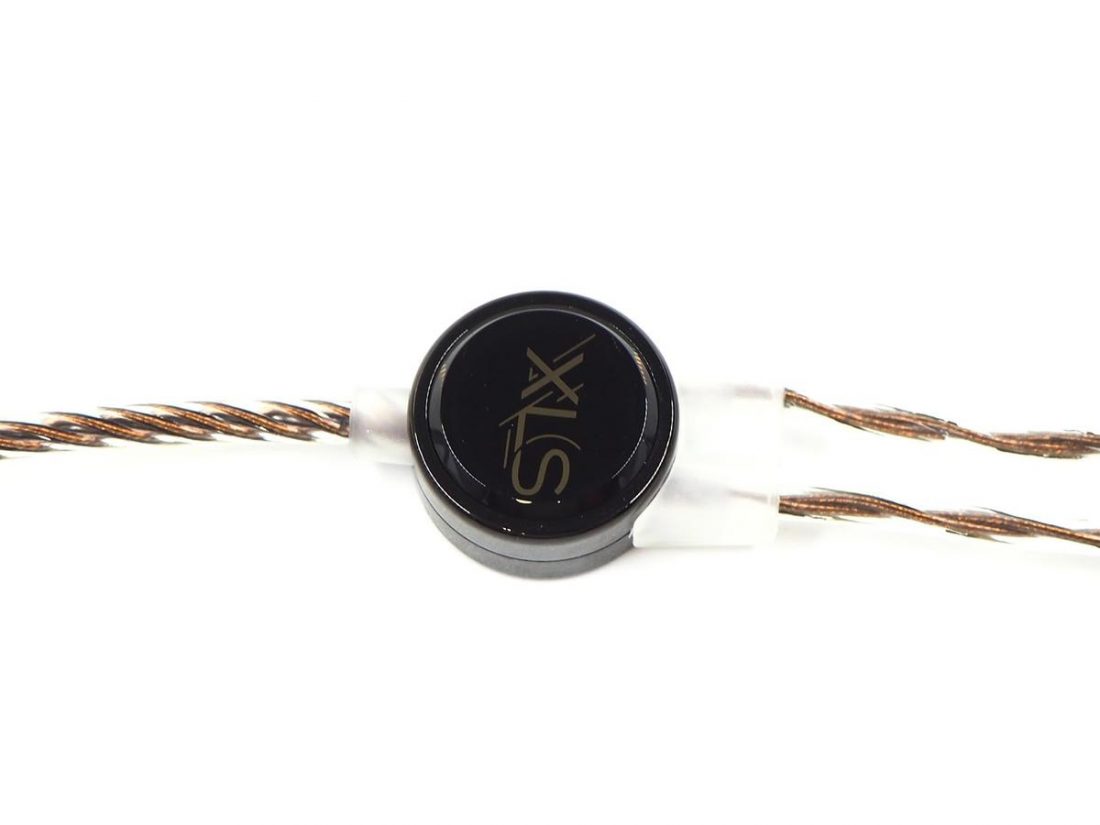
Splitter with “XLS”
Fit and Isolation
The Dream XLS has a slightly shallower fit. I always prefer a deeper insertion for better passive noise cancellation and isolation. The provided Final Audio Type-E ear tips can provide a good fit for me but the insertion is slightly too shallow. After a series of ear tips rolling, I settled down with SpinFit CP145 and MandarinES Symbio F. Both of them are giving me outstanding isolation with deep insertion.
With suitable ear tips, Dream XLS can provide good passive noise cancellation and isolation. I managed to bring Dream XLS out for some walks before the circuit breaker implemented in Singapore. It’s able to block out most of the surrounding noise from buses and railway systems. I can enjoy my music with Dream XLS during commuting.
Sound Analysis
For this review, I listened to Dream XLS extensively with it paired to Lotoo Paw 6000, Lotoo Paw S1 and iBasso DX220. I did a 200 hours burn-in for Dream XLS with my Lotoo Paw 6000. My Paw 6000 arrived a few days before Dream XLS and I did the burn-in together. Kenneth from Project Perfection especially recommended me the Paw 6000-Dream XLS pairing.
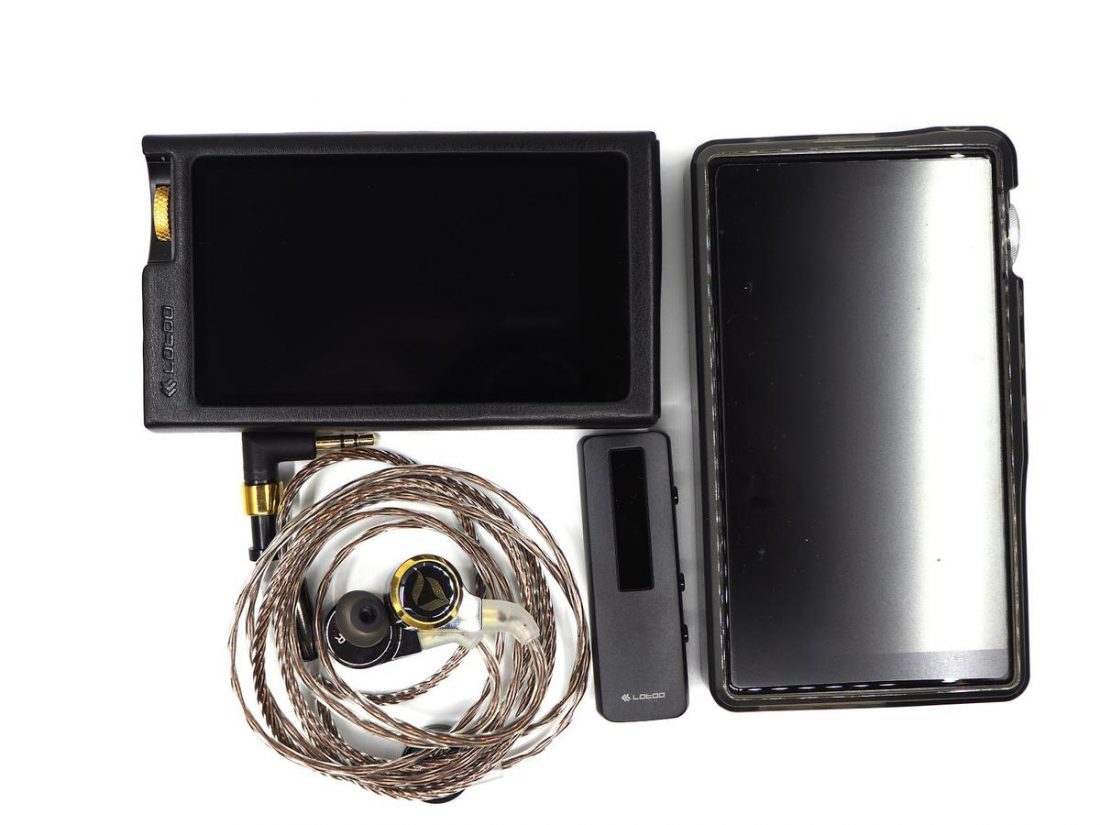
Lotoo Paw 6000, Psw S1, iBasso DX220 and DITA Dream XLS
Rated at 22 Ohms for impedance and 104db for sensitivity, Dream XLS is not hard to be driven. However, here’s my experience – I did audition with my Opus #3, which is less powerful compared to the three mentioned models. The sound signature of Dream XLS becomes thin and lean, which is quite different from the output of more powerful sources.
Then, I attached my Opus #3 to a dedicated amplifier, ALO Audio RX and the result is more promising now – close to what I get from the three mentioned models.
Feed the Dream XLS with sufficient power and you will not be disappointed. It will sing sweetly and smoothly. Tested and proven!
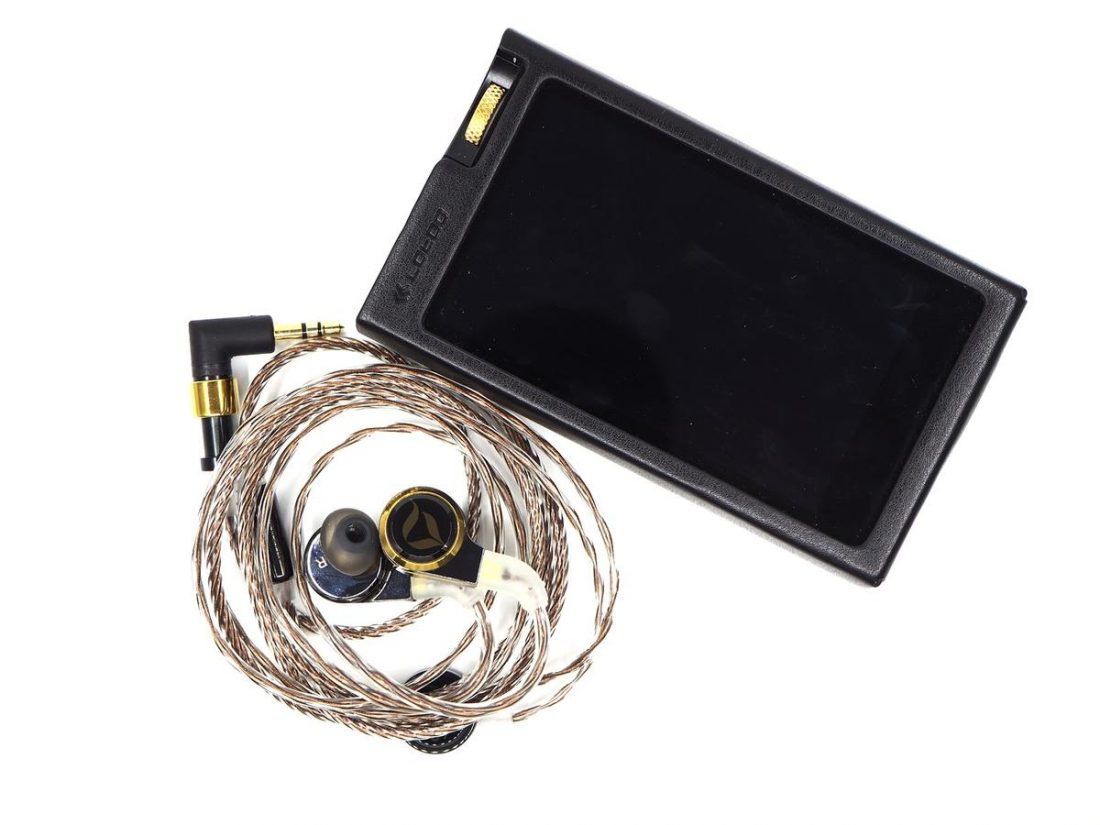
DITA Dream XLS with Lotoo Paw 6000
Sound Signature
Dream XLS has a neutral and well balanced sound signature. You are not getting any extra decibels from any frequencies. The presentation is natural and lively – minimum coloration can be observed during this period of extensive listening with Dream XLS.
Let’s talk about the texture of Dream XLS. I will define texture as how the tempo, melodic, and harmonic materials are layered in a composition, thus determining the overall quality of the sound from the IEMs. Dream XLS has good thickness in terms of texture – instruments are well-layered and delivered to the users. The presentation has a rich body.
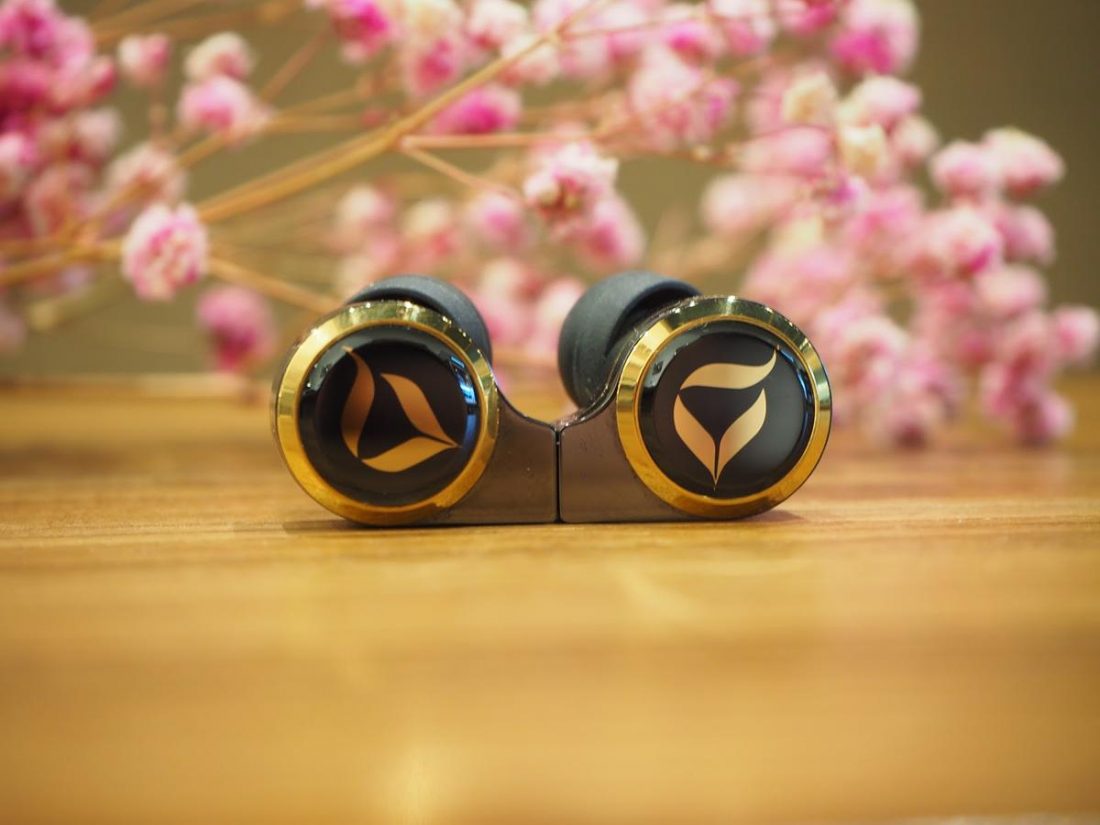
DITA Dream XLS
Soundstage
For those who are not aware, the term XLS in the model name stands for Xtra Large Soundstage, which is mentioned in the title of this article. Without disappointment, Dream XLS presents the music with bold and unexaggerated wide soundstage.
No congestion and collision, every note in the track has its dedicated position and delivered to the user accurately. This is how precise the presentation of Dream XLS is.
The presentation from Dream XLS is very accurate. I can identify the positions of instruments and vocals effortlessly. In more complicated genres like rock bands, Dream XLS can handle every note from different instruments well, delivering them in good layering, without congestion and sacrificion.
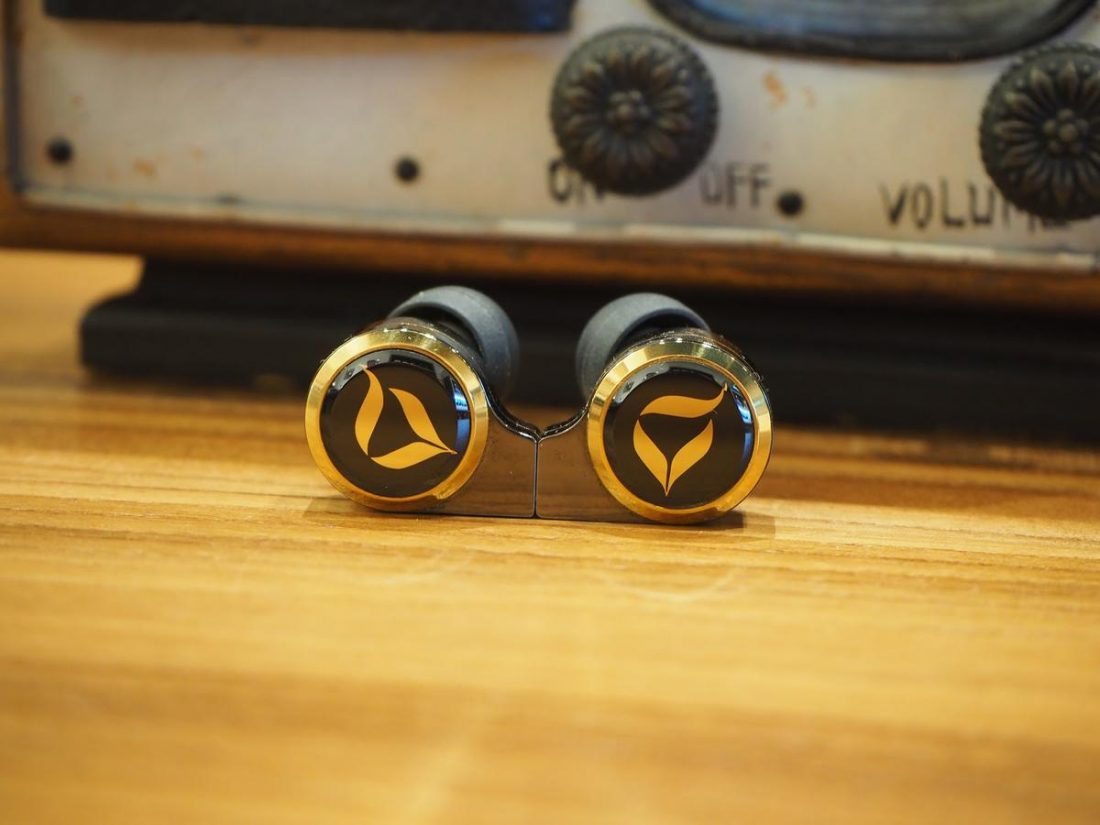
DITA Dream XLS
Lows
Unlike typical dynamic driver powered IEMs, Dream XLS does not have bombastic bass response. The bass characteristic of Dream XLS is lean and tight, which results in an accurate and precise presentation.
The Dream XLS has a fast attacking and decaying bass, which is different from conventional dynamic driver IEMs. This could be one of the dynamic driver IEMs with the least bass quantity I experienced. It’s definitely not a basshead-level IEMs.
The sub-bass has a good extension, creating a good depth in terms of soundstage. It hits tightly and deeply, without causing any effect to other frequencies. It’s like a good shadow to the track – present but not affecting. The rumbles from the sub-bass can definitely be felt. I would call it a high quality sub-bass.
Listening to Bon Jovi’s Brokenpromiseland, the ending sub-bass has very good rumbles and I can feel it.
The mid-bass is slightly forward compared to the sub-bass. The speed is as fast as the sub-bass. The fast decay controls the bass region very well, minimizing the bleeding towards the mids. The overall comment I give to the bass region is clean, clear and well-controlled. Precision is the key word to describe the bass!
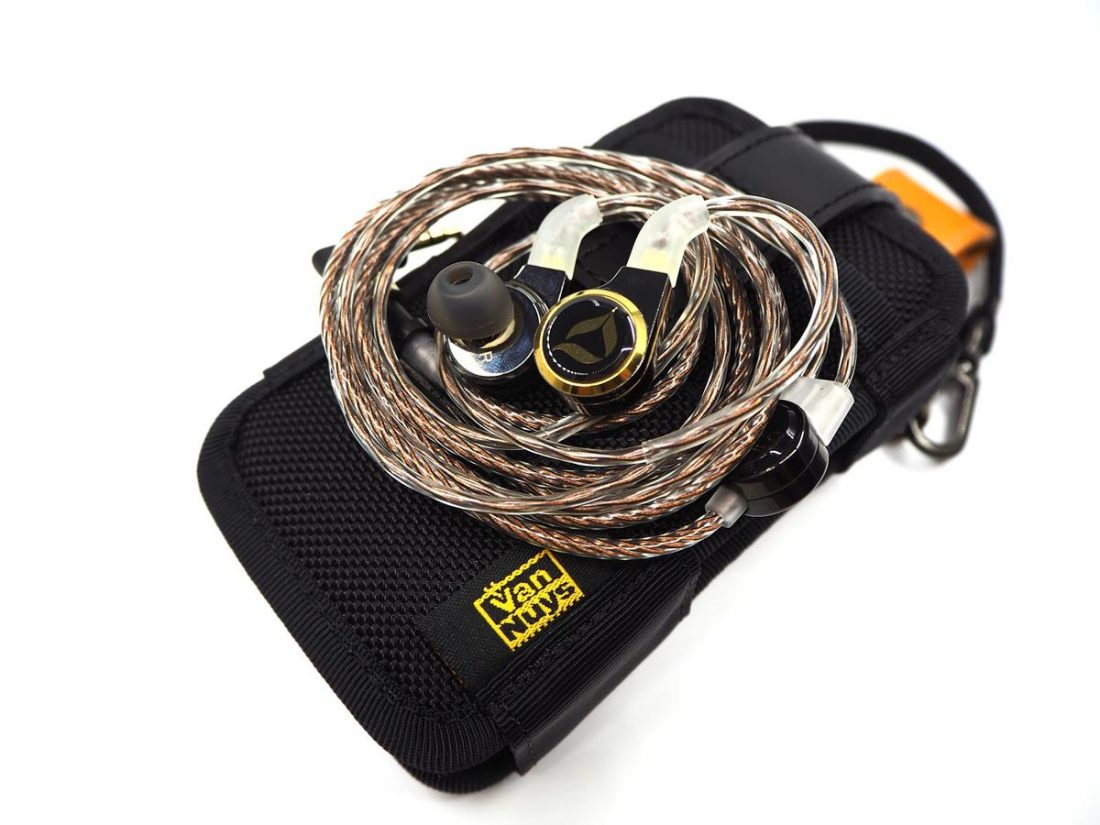
DITA Dream XLS on Van Nuys pouch
Mids
Dream XLS shines with its astonishing mids presentation – natural, rich and transparent vocals won my heart.
I will definitely list the mids presentation of Dream XLS as its unique selling point. The mids have a rich body and are very natural – just like listening to a live presentation. It’s well-balanced between analytically dry and colored wet. The lower midrange is firm and well-penetrating. I have to recommend Dream XLS for this particular recording – The Greatest Basso from Zhao Peng. It created an autonomous sensory meridian response (ASMR) effect for me.
ASMR signifies the subjective experience of “low-grade euphoria” characterized by “a combination of positive feelings and a distinct static-like tingling sensation on the skin”. It’s most commonly triggered by specific auditory or visual stimuli, and less commonly by intentional attention control.
The upper mids are transparent – spacious and airy. It has similar characteristics to the highs, which I will elaborate more in the next section. Listening to female vocals, the presentation is smoothly soft, tickling the eardrums. It has good penetration, just like the lower midrange.
I auditioned Norah Jones’ latest album Begin Again with Dream XLS. The vocals are presented with a rich body and preserved sufficient amount of air. The fidelity is outstanding!
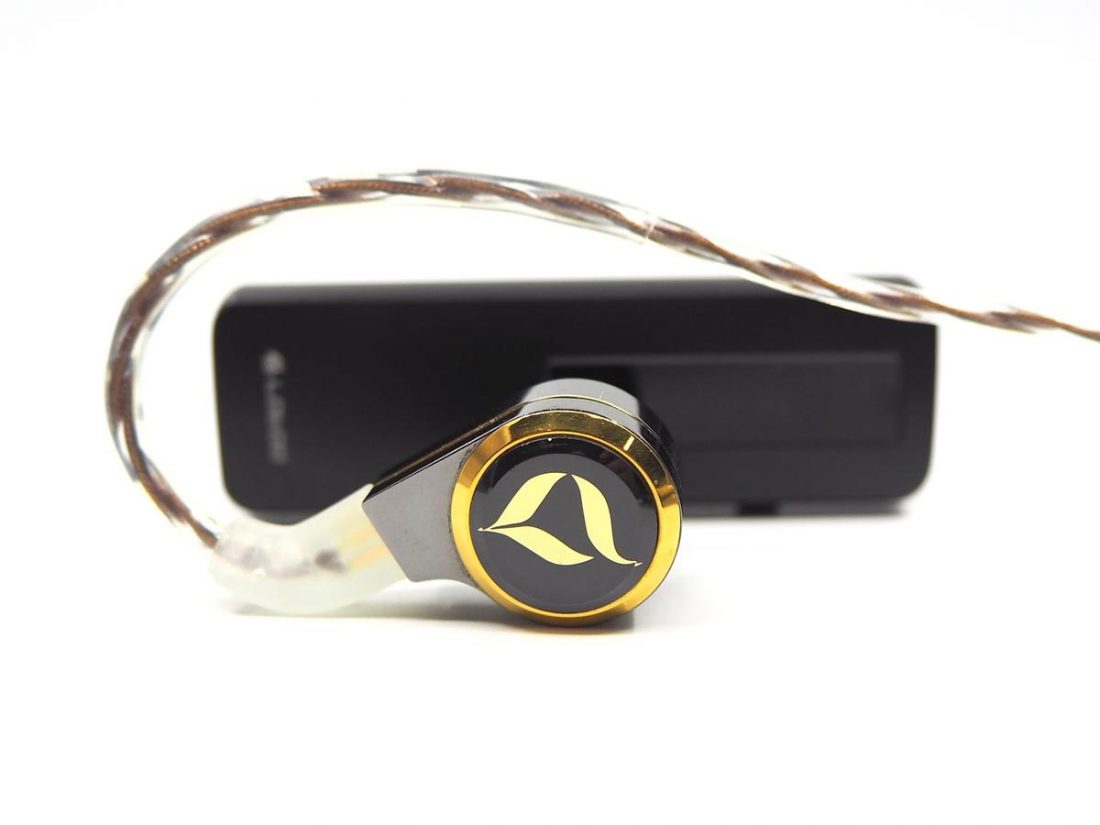
DITA Dream XLS with Lotoo Paw S1
Highs
The highs of Dream XLS is very well-extended and the decays have been handled controllably. There is no distortion in the high frequencies. There is sufficient air and space injected in the highs, creating a spacious soundstage that is full of air. This could be a secret weapon to create a Xtra Large Soundstage for Dream XLS.
The presentation of highs is natural – it’s not extended stiffly and exaggeratedly. Listening to Beethoven’s 5 Secrets by The Piano Guys, the woodwinds instruments used (flute and oboe) are presented smoothly and with rich texture. It is close to how those instruments should sound in reality. For string instruments like violin, the delivery is smooth, too.
I don’t experience any fatigue for long listening of three to four hours daily during the review period. I might have a better treble tolerance as I always prefer a brighter sound signature. For those who are fans of darker sound signature, the slightly forward treble could cause fatigue.

DITA Dream XLS
Verdict
The DITA Dream XLS is, indeed, the flagship model from DITA Audio, in both build and sonic quality. The high fidelity presentation with astonishing build, Dream XLS can definitely challenge flagship IEMs from various manufacturers. If my bank account allows, I would like to acquire it without a doubt.
The cumulation of a decade of dynamic driver IEM work by Dita Audio: Dream XLS combines the best of all their releases with additional space and soundstage.
DITA Dream XLS is retailing at USD$2299. You can purchase it from DITA Audio Official Website.
With the launch of Dream XLS, DITA Audio once again proves to the world that the matured state of the dynamic driver used in audiophile-grade sound reproduction is a testament to the longevity and practical benefits of it. Well done, DITA Audio!
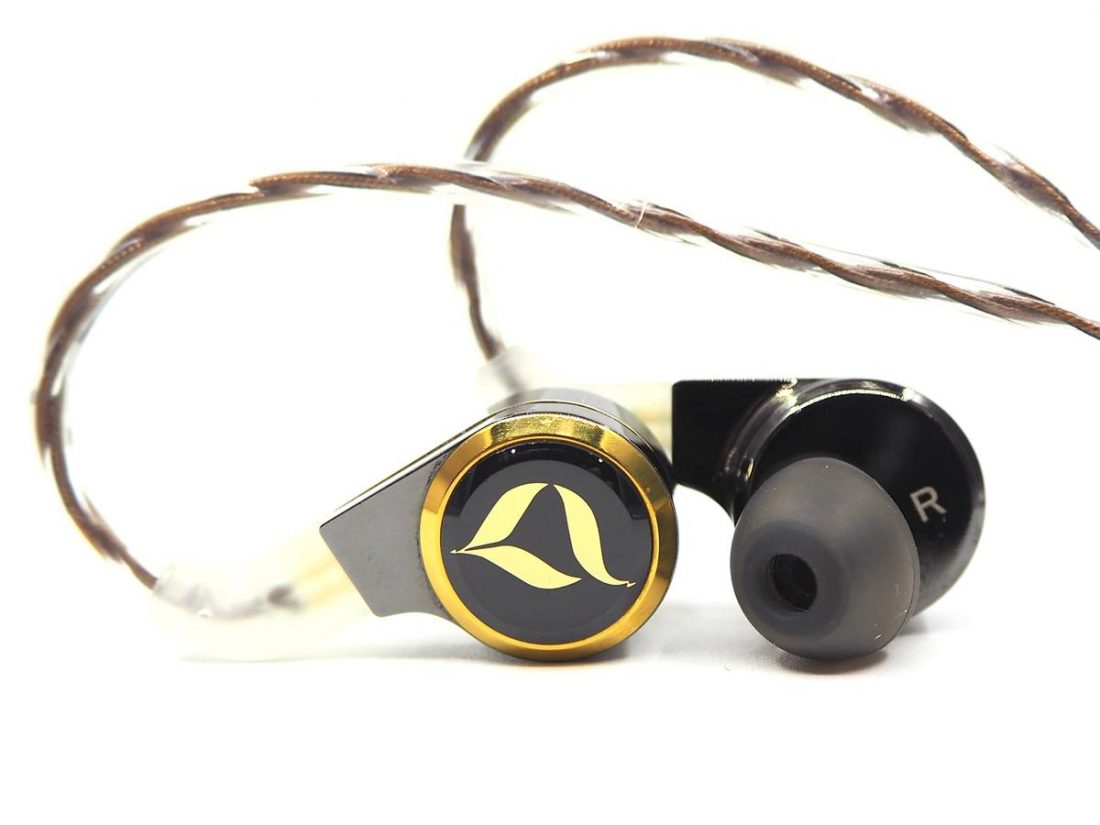
The cumulation of a decade of dynamic driver IEM work by Dita Audio: Dream XLS combines the best of all their releases with additional space and soundstage
Disclaimer
This article is originally posted on Headphonesty. Thank you, Project Perfection Pte Ltd, authorised distributor for DITA Audio for loaning me the Dita Dream XLS in-ear monitors (IEMs). It was loaned to me in exchange for my honest review and opinion. The unit will be returned to Project Perfection after this review.
Introduction
Established in 1971, Packagers Pte. Ltd, parent company of DITA Audio, has 49 years of research and experience in automation and engineering. DITA Audio adopts the experience and methodology from the parent company to build audio products that are supreme in both build and sonic quality. Besides the experience from Packagers, DITA is constantly driving collaboration ventures with potential parties in different sectors – to enhance design, engineering and manufacturing.
In 2015, the Answer was awarded the President’s Design Award for its exemplary quality in build and thoughtful user experience consideration. In Singapore, the President’s Design Award is the highest honor for designs across all design disciplines. The award recognises the outstanding contributions by a group of people that is working hard to yield a difference to the lives of both Singaporeans and people around the world.
DITA Audio did not stop there. With the recognition from fellow Singaporeans, DITA continues their journey to conquer the audiophile communities around the world. With the lesson learnt in designing the first generation of Dream and experiences from various collaboration ventures such as collaborating with the venerable Dutch cable company, Van Den Hul, DITA launched their latest Flagship, Dream XLS to update their current lineup.
From sound signature to design and appearance, every facet of the Dream XLS is a labor of love and DITA’s endeavour to bring all it knows to your listening sessions. Let’s explore the Dream XLS in this article!
Unboxing

The outer box of DITA Dream XLS

The luxury box with gold and black colour combination

“XLS” on the side of the box
Opening the heavy, luxurious box, the inside is separated into two sections – Dream XLS with cable attached is in the upper section and other accessories such as cases and ear tips occupy the lower section.

Dream XLS makes its first appearance

A short notes from co-creators

The service pack and Dream XLS occupy the top section of the box while other accessories occupy the remaining half.
Here are the accessories that you can expect in the box:
- Oil Soaked Long-crystal Oxygen-free for Dream XLS (OSLO-XLS) stock cable
- Switchable Awesome Plugs (2.5mm/3.5mm/4.4mm)
- Hard leather case
- Soft leather pouch
- 5 pairs of Final Audio Type-E ear tips
- 3 pairs of stock silicone eartips
- 2 pairs of spare nozzle meshes
- A set of Dita stickers
- Service pack (paperwork and a warranty card)

Service Pack


The soft case

The soft case

The hard case

The hard case

Storing Dream XLS in the soft pouch

Storing Dream XLS in the hard case

Box for ear tips, awesome plugs, fibre cloth and spare meshes for nozzle

Box for ear tips, awesome plugs, fibre cloth and spare meshes for nozzle
Technical Specification
- Driver Type: Ultra-linear 10mm Dynamic Driver Gen. XLS
- Frequency response: 10 – 25KHz
- Sensitivity: 104 dB
- Impedance: 22 Ohms
- Connection (Plug End): DITA Awesome Plug – Including interchangeable plugs for 2.5mm TRRS, 4.4mm TRRRS and 3.5mm TRS Single Ended
- Connection (Earphone End): XLS 2-Pin
- Cable: OSLO-XLS Cable
- Chassis Material: Grade 1, 6Al-4V Titanium
- Splitter: Stainless Steel and Sapphire
- Colour: Obsidian Black
Chassis
Made entirely in Japan, the Dream XLS has an intricate, computer numerical controlled (CNC)-milled Titanium chassis with sapphire crystal faceplates created specifically for the XLS. For a dream class product, DITA only uses materials that their research deem worthy. For this expression of sound, titanium lends it’s flavor for exceptional smoothness and resolution. The chassis is hand polished to a mirror shine.

The build of Dream XLS is indeed very solid – a smooth surface with the titanium glowing. It immediately shows the flagship characteristic of Dream XLS. On top of the shell, users can find the recessed 2-pin connector. I did some cable rollings and 0.78mm 2-pin cables fit well with Dream XLS.

The 2-pin connector on top of the shell
The titanium nozzle is in one piece with the shell. The diameter of the nozzle can be considered averagely wide. Most of my ear tips such as SpinFit CP145 and MandarinES Symbio F can fit the nozzle well. There is a lip on the nozzle to provide a secure catch to the ear tips.

The nozzle of Dream XLS

The nozzle of Dream XLS

Dream XLS with MandarinES Symbio F ear tips
Dynamic Driver
The Dream XLS features the DITA Ultra-linear composite Dynamic Driver Gen XLS, which is specially designed by DITA for Dream XLS. According to DITA Audio, the improved composite dynamic driver improves resolution, sensitivity and emotional engagement. When the DITA Ultra-linear composite driver is paired with the titanium acoustic chamber, the driver is allowed to utilize the characteristics of titanium; fast, dynamic and control.

DITA Dream XLS with Van Nuys Case
Cable
An Oil Soaked Long-crystal Oxygen-free for Dream XLS (OSLO-XLS) cable is specially optimized and provided for the Dream XLS. Based on a Pure Copper-Continuous Crystal Construction (PC-Triple C) high purity copper that is extruded and soaked in a squalene suspension of gold and silver nanoparticles, it results in smoothening microscopic surface irregularities and eventually yielding a better contact and smoother signal transfer.
The sleeve of the cable is improved to be smooth and easy to manage. The Dream XLS comes with the full suite of an Awesome Plug to suit your digital audio player (DAP) out of the box.
The Awesome Plug is DITA’s future-proof solution to the traditional earphone plug, allowing the hobbyist to use a multitude of configurations on the plugs end. The plug is interchangeable and available in 2.5mm TRRS, 3.5mm TRS and 4.4mm TRRRS. The 90-degree nature of the plug is kept functional and minimally intrusive when used directly with smart devices.

OSLO-XLS

Dream XLS 2-Pin Connector

The awesome plug

Splitter with “XLS”
Fit and Isolation
The Dream XLS has a slightly shallower fit. I always prefer a deeper insertion for better passive noise cancellation and isolation. The provided Final Audio Type-E ear tips can provide a good fit for me but the insertion is slightly too shallow. After a series of ear tips rolling, I settled down with SpinFit CP145 and MandarinES Symbio F. Both of them are giving me outstanding isolation with deep insertion.
With suitable ear tips, Dream XLS can provide good passive noise cancellation and isolation. I managed to bring Dream XLS out for some walks before the circuit breaker implemented in Singapore. It’s able to block out most of the surrounding noise from buses and railway systems. I can enjoy my music with Dream XLS during commuting.
Sound Analysis
For this review, I listened to Dream XLS extensively with it paired to Lotoo Paw 6000, Lotoo Paw S1 and iBasso DX220. I did a 200 hours burn-in for Dream XLS with my Lotoo Paw 6000. My Paw 6000 arrived a few days before Dream XLS and I did the burn-in together. Kenneth from Project Perfection especially recommended me the Paw 6000-Dream XLS pairing.

Lotoo Paw 6000, Psw S1, iBasso DX220 and DITA Dream XLS
Rated at 22 Ohms for impedance and 104db for sensitivity, Dream XLS is not hard to be driven. However, here’s my experience – I did audition with my Opus #3, which is less powerful compared to the three mentioned models. The sound signature of Dream XLS becomes thin and lean, which is quite different from the output of more powerful sources.
Then, I attached my Opus #3 to a dedicated amplifier, ALO Audio RX and the result is more promising now – close to what I get from the three mentioned models.
Feed the Dream XLS with sufficient power and you will not be disappointed. It will sing sweetly and smoothly. Tested and proven!

DITA Dream XLS with Lotoo Paw 6000
Sound Signature
Dream XLS has a neutral and well balanced sound signature. You are not getting any extra decibels from any frequencies. The presentation is natural and lively – minimum coloration can be observed during this period of extensive listening with Dream XLS.
Let’s talk about the texture of Dream XLS. I will define texture as how the tempo, melodic, and harmonic materials are layered in a composition, thus determining the overall quality of the sound from the IEMs. Dream XLS has good thickness in terms of texture – instruments are well-layered and delivered to the users. The presentation has a rich body.

DITA Dream XLS
Soundstage
For those who are not aware, the term XLS in the model name stands for Xtra Large Soundstage, which is mentioned in the title of this article. Without disappointment, Dream XLS presents the music with bold and unexaggerated wide soundstage.
No congestion and collision, every note in the track has its dedicated position and delivered to the user accurately. This is how precise the presentation of Dream XLS is.
The presentation from Dream XLS is very accurate. I can identify the positions of instruments and vocals effortlessly. In more complicated genres like rock bands, Dream XLS can handle every note from different instruments well, delivering them in good layering, without congestion and sacrificion.

DITA Dream XLS
Lows
Unlike typical dynamic driver powered IEMs, Dream XLS does not have bombastic bass response. The bass characteristic of Dream XLS is lean and tight, which results in an accurate and precise presentation.
The Dream XLS has a fast attacking and decaying bass, which is different from conventional dynamic driver IEMs. This could be one of the dynamic driver IEMs with the least bass quantity I experienced. It’s definitely not a basshead-level IEMs.
The sub-bass has a good extension, creating a good depth in terms of soundstage. It hits tightly and deeply, without causing any effect to other frequencies. It’s like a good shadow to the track – present but not affecting. The rumbles from the sub-bass can definitely be felt. I would call it a high quality sub-bass.
Listening to Bon Jovi’s Brokenpromiseland, the ending sub-bass has very good rumbles and I can feel it.
The mid-bass is slightly forward compared to the sub-bass. The speed is as fast as the sub-bass. The fast decay controls the bass region very well, minimizing the bleeding towards the mids. The overall comment I give to the bass region is clean, clear and well-controlled. Precision is the key word to describe the bass!

DITA Dream XLS on Van Nuys pouch
Mids
Dream XLS shines with its astonishing mids presentation – natural, rich and transparent vocals won my heart.
I will definitely list the mids presentation of Dream XLS as its unique selling point. The mids have a rich body and are very natural – just like listening to a live presentation. It’s well-balanced between analytically dry and colored wet. The lower midrange is firm and well-penetrating. I have to recommend Dream XLS for this particular recording – The Greatest Basso from Zhao Peng. It created an autonomous sensory meridian response (ASMR) effect for me.
ASMR signifies the subjective experience of “low-grade euphoria” characterized by “a combination of positive feelings and a distinct static-like tingling sensation on the skin”. It’s most commonly triggered by specific auditory or visual stimuli, and less commonly by intentional attention control.
The upper mids are transparent – spacious and airy. It has similar characteristics to the highs, which I will elaborate more in the next section. Listening to female vocals, the presentation is smoothly soft, tickling the eardrums. It has good penetration, just like the lower midrange.
I auditioned Norah Jones’ latest album Begin Again with Dream XLS. The vocals are presented with a rich body and preserved sufficient amount of air. The fidelity is outstanding!

DITA Dream XLS with Lotoo Paw S1
Highs
The highs of Dream XLS is very well-extended and the decays have been handled controllably. There is no distortion in the high frequencies. There is sufficient air and space injected in the highs, creating a spacious soundstage that is full of air. This could be a secret weapon to create a Xtra Large Soundstage for Dream XLS.
The presentation of highs is natural – it’s not extended stiffly and exaggeratedly. Listening to Beethoven’s 5 Secrets by The Piano Guys, the woodwinds instruments used (flute and oboe) are presented smoothly and with rich texture. It is close to how those instruments should sound in reality. For string instruments like violin, the delivery is smooth, too.
I don’t experience any fatigue for long listening of three to four hours daily during the review period. I might have a better treble tolerance as I always prefer a brighter sound signature. For those who are fans of darker sound signature, the slightly forward treble could cause fatigue.

DITA Dream XLS
Verdict
The DITA Dream XLS is, indeed, the flagship model from DITA Audio, in both build and sonic quality. The high fidelity presentation with astonishing build, Dream XLS can definitely challenge flagship IEMs from various manufacturers. If my bank account allows, I would like to acquire it without a doubt.
The cumulation of a decade of dynamic driver IEM work by Dita Audio: Dream XLS combines the best of all their releases with additional space and soundstage.
DITA Dream XLS is retailing at USD$2299. You can purchase it from DITA Audio Official Website.
With the launch of Dream XLS, DITA Audio once again proves to the world that the matured state of the dynamic driver used in audiophile-grade sound reproduction is a testament to the longevity and practical benefits of it. Well done, DITA Audio!

The cumulation of a decade of dynamic driver IEM work by Dita Audio: Dream XLS combines the best of all their releases with additional space and soundstage
Last edited:
Wyville
Headphoneus Supremus
Pros: Neutral-natural tonality, highly detailed yet easy going, build quality, OSLO-XLS cable, good selection of accessories, general attention to detail
Cons: Need time to run in, fit might not work equally well for everyone
DITA Audio Dream XLS - Enticing musicality
Disclaimer
I would like to thank DITA Audio and Project Perfection for providing me with the DITA Dream XLS in exchange for my honest opinion. No incentive was given for a favourable review.
Dream XLS
Links:
https://ditaaudio.com
https://www.facebook.com/DitaAudio/
https://www.pp-distribution.com
https://www.facebook.com/projectperfectionsg/
Preamble
As a reviewer I enjoy trying out all sorts of gear from companies with a wide range of different philosophies behind their products and I love exploring that diversity. It is fascinating to get in touch with the people behind the product, some of whom are mad scientists, while others very talented artists or they just radiate passion for their work. Some companies though resonate with me more than others and those are companies like DITA Audio. DITA make products that steer away from short product cycles with lots of hype, instead they take their time to develop "perennial" (sorry, I've been gardening a lot lately) products with meticulous attention to detail. I deeply appreciate that. It is a sort of paradox that while I review because I am interested in exploring many products, I am also someone who loves to cherish things. Many of the items I have bought for my various hobbies go through their entire life cycle while I own them. So as a reviewer I am biased towards products that I feel have a lasting value. I am also a sucker for single dynamic driver IEMs, so naturally DITA is a company that stays firmly on my radar.
Unboxing
This is usually the section of my reviews I add mainly for the benefit of those readers who are interested in seeing what comes in the box. For myself I generally don't care too much about it and just want to get to the good stuff ASAP. I have seen a few nice presentations with the packaging and occasionally did secretly enjoy it, but I can't really remember having an experience quite like I had with the Dream XLS. Perhaps it is because the box has a unique layout (as far as I have seen, anyway) or perhaps because it is a big box with loads of stuff or maybe it is because the box has a complete sticker set hidden away at the bottom. In any case, it genuinely impressed me and made it abundantly clear a lot of thought went into creating packaging that is befitting a >$2k pair of earphones.
The Dream XLS come in a large white box with minimal details in which you find the box proper. It is a large flat black box with golden details that opens up to reveal the Dream XLS monitors a 'service pack' covering the cable and a card with a personal note from Danny and Desmond, the co-founders of DITA Audio. Underneath the card are boxes with the hard case, the soft case and one containing a selection of tips and additional balanced plugs (both 2.5mm and 4.4mm) for the Awesome plug. The service pack has the manuals and importantly a metal card with the serial number on it. Once all the boxes have been removed a set of stickers is revealed on the bottom of the box.





I think the selection of items included is very good. The soft case is familiar to those who have owned other DITA products, as I have seen similar cases with (for instance) the Truth cables. The hard case looks like it was uniquely designed for the Dream XLS, made from tough leather with a cord so you can carry it around easily. I preferred using the soft case because I have the Dream XLS stored away safely in my designated audio drawer, but the hard case naturally offers more protection for on the go. The selection of tips is modest, but sufficient, with Final E-tips (my most used tips) and slightly wider bore silicone tips. That DITA included both 2.5mm and 4.4mm balanced plugs in addition to a 3.5mm single ended plug is great and what I would expect at this price point. It is such an important aspect of what makes the Awesome plug so versatile that leaving it out would have been a real miss.




I really enjoyed the unboxing experience and think DITA did very well to make it feel special and how you want it to be when spending this much money on a pair of IEMs. The only way to top it would be the sort of opulent wooden chest I have seen with the Vision Ears Erlkönig, which are twice as expensive.
Build quality and fit
That DITA have a meticulous attention to detail is abundantly clear from the build quality of the Dream XLS and the OSLO-XLS cable. The Dream XLS is based around a completely new 'ultra linear' 10mm dynamic driver that is housed in a solid titanium shell. A long long time ago, in a different life (sounds like I am starting a fairy tale here), I learned how to machine various types of metal and so it was very interesting to read the 'XLS Production Diaries' that DITA have published on their website. In those diaries they explain a bit more about the CNC machining and finishing of the titanium shells. It is not an easy process and precision is paramount to the performance of the monitors. When you look at the final product, you can really see how precisely the work has been done, as the units look flawless... just as long as you don't touch them with your bare hands because the ion plated obsidian black finish is a fingerprint magnet. The titanium shells have also been fitted with sapphire glass to cover the DITA logo for added durability, as well as a very clean look. I think it looks stunning and oozes quality. There is no doubt in my mind that these are built to last a long time.

Image courtesy of DITA Audio

Image courtesy of DITA Audio

The cable that is included is based on DITA's previously released OSLO cable, although specifically adjusted to fit the sound characteristics and looks of the Dream XLS. It has the same Oil-Soaked Long-crystal Oxygen-free (OSLO) wires and Awesome plug as the generally available OSLO cable, but the parts all match the colour scheme of the Dream XLS very nicely. The only parts that do not perfectly match are perhaps the clear XLS 2-pin connectors. I think it might have been nice if those had matched to obsidian black of the shells, but that is really nit picking. The connectors themselves are a great quality, nothing elaborate, but functional with a solid feel. The y-split matches the shells very nicely, as does the gold accent on the Awesome plug. The cable as such is fantastic and I love using it. It is very supple and comfortable, and together with the Awesome plug it deters me from trying any other cable, which is quite a statement for this pathological cable-roller. It is so convenient to have a cable that scores top marks in every aspect.
The Dream XLS are a joy to use and the fit works really well for my ears. I am aware that this might not be the case for everyone, so if you have issues with a shallower fit -the Dream XLS don't sit very deep- then it might be worth specifically checking if the fit will work for your ears. I have gone back and forth between the two types of tips and ended up settling with the wider bore silicone tips mainly because of a slightly more secure fit and tighter seal.
Source
All listening was done with the Lotoo PAW6000, a neutral DAP with excellent transparency for hearing subtle differences. I did not use any of the PAW6000's PMEQ or ATE settings.
Presentation
Before I go into the presentation proper there are two things worth noting. First, the Dream XLS appeared to change quite noticeably over time. I usually ignore any burn in effects and just let gear run for 100 hours before I start working on the review (as a courtesy to the manufacturer). With the Dream XLS I listened to them early on -how could I resist- and felt they had quite a noticeable lower treble lift and lacked some of the warmth I had expected beforehand. However, once past 100 hours, the Dream XLS sounded noticeably more balanced. The reason I noticed it so clearly was my second point, namely that the Dream XLS also seem quite tip sensitive. Where I usually use Final E-tips because I get a good fit with those and like what they do with the sound, I soon switched to the other, wider bore, silicone tips that were included. With the Final E-tips I found the Dream XLS somewhat fatiguing early on and the wider bore tips toned that down a little. However, after well passed the 100-hour mark, I went back to try the E-tips again and was surprised by how balanced everything sounded. Even with recordings that I knew were prone to sibilance I had no issues. I also found that male vocals got a bit more presence because of a slight warming of the signature, giving male vocals the chestiness they need. So although I tend to avoid any statements on burn in, I will make an exception with the Dream XLS and recommend a proper burn in of comfortably passed 100 hours.
The Dream XLS have quite a unique presentation that reminds me a little of the Fealty, the same DNA is there, but mixed with a certain reference quality. I would not call them all-rounders, but that is of course subject to personal preferences. For me they do little for EDM for instance, for that I feel they lack some excitement, but when it comes to acoustic music, jazz and classical I think they are a joy to listen to.

The Dream XLS present music in a very large stage that pushes the music out of the head in a way that I have not had with IEMs that often. It is very spacious and feels natural, like the sound is coming from beyond the monitors themselves. It is incredibly pleasant and made even better by the natural coherency that this single dynamic driver can offer. Separation is excellent, but instruments are not isolated or presented with a huge amount of air around them (although there is still plenty of air) and this greatly benefits coherency in the image. The music has liquidity to it where the notes flow from one instrument to another. It is a quality I am very fond of because it is where I find the soul of music, all the emotion that makes music such a unique medium for expression. All the while it remains easy to pick out every single instrument, even those way in the background. Every detail is presented very clearly, surprisingly so at times, and this is where I see that reference quality. All the information is there, and yet it is presented with a gentle smoothness that is incredibly seductive. The image itself is rock solid and positional information is without doubt among the very best I have heard. The tonality is what I would consider neutral-natural, similar to the Fealty. There is a hint of warmth throughout the signature, just enough to give instruments accurate timbre and give the signature a wonderfully dynamic nature. The Dream XLS don't push anything forward, they don't force musicality, instead they entice you into the music and reward you plentiful if you let them. I found that with the Fealty and the Dream XLS take that characteristic and lift it up a notch.
Bass
Contrary to what you might expect from the dynamic drivers, the Dream XLS are not IEMs that will sooth the inner bass head. I love physicality in my bass and there is very little of that to be found here. I would call the bass, to borrow a term, "unexcited". The bass extends deep, but feels a little attenuated lower down and the mid-bass kick feels toned down a notch as well. All in all, an understated bass that is positioned perhaps slightly back in the image. However, that does not mean it is boring or lifeless, it simply does not push itself more forward than it needs to. In classical pieces such as Bedřich Smetana's Ma Vlast 'Vltava' or Tchaikovsky's The Nutcracker 'The Battle' scene of Act 1, the capabilities of the bass are clearly displayed. It is dynamic and there is force to the instrument that portrays something like thunder -which in Ma Vlast portrays the current of the river Vltava- while that thunderous rumble is never overpowering. It is polite, yet capable of conveying exactly what the instrument is meant to convey. Here again I find something of a reference quality to it, as the Dream XLS' bass gives you a lot of information. It gives you all the detail and all the texture of an instrument, while restraining itself from throwing it in your face and muddling up the rest of the signature. It is exceptionally well controlled. Make no mistake, I love a bass that is right there in my face, rattling my jaw, and part of me wishes there was more of that with the Dream XLS, but I think it would ruin their unique characteristic, that effortlessness they have.
Bach's Cello Suite as performed by Yo-Yo Ma illustrates the strength of the Dream XLS' bass beautifully as well. It portrays the cello in a highly dynamic way, where you can hear the resonance in the body of the cello very clearly with the low notes, while it transitions more towards the playing techniques on the strings with the higher notes. There is a huge amount of detail in it and seems to pull all the layers of complex passages apart, while never sacrificing coherency.

Mids
The mids are very natural with excellent timbre. I am quite a fan of a warmer midrange with full sounding instruments and while the Dream XLS don't push it quite that far, they are a joy to listen to. I always come back to John Eliot Gardiner's rendition of Beethoven's 5th symphony for timbre because his orchestra uses period instruments, which he explained adds a unique layering to the performance. The Dream XLS perform incredibly well here. I dare say that this might well be the best I have heard it so far. The Dream XLS seem to pick apart the complex layering with ease and convey the subtle tonal differences with great precision and a wide dynamic range, yet notes always flow from one instrument to another with the liquidity I mentioned earlier. With a symphony so full of emotion as Beethoven's 5th, it is an absolute joy to listen to.
Vocals are positioned fairly neutral, not too forward and not pushed into the background either. I am a lover of great vocals and so don't mind it if vocals are a little more forward, as it can give a sense of intimacy when listening to my favourites like Madeleine Peyroux, Agnes Obel and London Grammar's Hannah Reid. The Dream XLS don't quite give that 'whisper in your ear' type of intimacy, but vocals are strong, with excellent definition and clarity. Initially I felt female vocals were favoured, but as I explained earlier, with time male vocals have come up nicely with good chestiness to deeper male vocals and it resulted in a better balance between the two. Female vocals might still have a slight edge due to an upper-mid emphasis, but that could also be because I was completely seduced by Elin Manahan Thomas (please don't tell my wife). The effortlessness with which the Dream XLS portrayed her voice gave it an almost ethereal quality when listening to her sing Handel's Ode for the Birthday of Queen Anne. It is a great example of how the Dream XLS can entice you into the music, where I found I simply stopped doing whatever I was doing to close my eyes and drift away on every subtle vibrato in her crystal clear voice.
Treble
Here of course the difference is most notable between a well-used pair of the Dream XLS and a pair that is fresh out of the box. The Dream XLS have a lower treble lift that is more noticeable early on, although it will always be there. It adds some excitement as it articulates note clarity, but it is an area where some people can be more sensitive, myself included. That is why I noticed the difference over time. After around the 100-hour mark I did not have any problems with it anymore, although I felt that at times some piano recordings still pushed it a hint too far on the higher notes, making the piano sound less rounded than I think is natural. For violins however it works a treat. When listening to Paganini's Violin Concerto #1 there was great articulation of the violin towards the end of the first movement, it gave me a tingling sensation as the bow jumped over the strings. There is so much texture and detail to the strings that it feels as if I can follow every individual finger movement and every touch of the bow.
The treble is well extended, although not pushed in a way where you get excessive sparkle. Much like the bass, the treble as an unexcited quality. There is a delicate sparkle that is always easy to discern, but never in your face or pushing background instruments forward. A sparkle in the background is reproduced by the Dream XLS exactly where it was intended to sparkle with all the detail you can imagine from it. Here too that imaging works exceptionally well, positioning and layering instruments with great precision.

Comparisons
-DITA Fealty-
The DITA Fealty have in recent times been my most used IEMs and so I was very curious to see how the Dream XLS compare. In pretty much every way the Dream XLS feel like a step up. Even though the Fealty have excellent build quality, the titanium shell of the Dream XLS feels even more solid and is finished to a higher standard as well. Both have excellent quality cables and it feels quite close here, but again the OSLO-XLS cable feels suppler than the Fealty's Fat cable and has a slightly more luxurious finish. The Fealty have one advantage in that they are a bit lighter in weight.
Sound-wise I hear a lot of similarities and would describe both as neutral-natural. The Fealty are a hint warmer throughout the signature with a smoother feel to them, making them a touch more forgiving. The Dream XLS are a little brighter, but without sacrificing the natural tonality. In technical performance the Dream XLS are a significant step up from the Fealty, offering a bigger stage with a lot more detail, texture and in general revealing more of the information in the music with greater clarity. I love what both have to offer and never feel like I am missing out when I listen to the Fealty, but I absolutely see the Dream XLS as a step up.
-FiR Audio M4-
Where the Dream XLS are based around a single dynamic driver, the M4 are based on a hybrid setup with three balanced armature drivers alongside a dynamic driver in a completely tubeless design and with FiR's 'Atom' pressure release system. The M4 are more U-shaped compared to the Dream XLS with an outstanding bass that goes a lot further to soothing my inner bass head, combined with a brighter overall signature.
Earlier I used the word 'unexcited' with the Dream XLS, but with the M4 the term 'excited' is more appropriate, although they are not over-the-top either. The bass of the M4 is still exceptionally well controlled and offers a lot of detail, but now with a proper rumble and great physicality. The mids of the M4 are leaner and the treble has a more prominent lower treble lift. Here I find the M4 less forgiving than the Dream XLS and it actually hits my treble sensitivity a bit too much with some recordings. Like the Dream XLS, the M4 offer a spacious stage with perhaps a bit more width and less depth by comparison.
Due to their different signatures I find the Dream XLS and M4 to be quite complimentary and I often find I have a clear preference for one or the other based simply on the music I want to listen to and the mood I am in.
-Empire Ears Phantom-
The Phantom might be designed around five balanced armatures, but I have always felt they had an almost dynamic driver character to them because of the level of texture they have on offer.
The Phantom again present something I would consider complimentary to the Dream XLS, although equally they can be seen as alternatives based on personal preferences. The Phantom offer a much more intimate stage, warmer signature and lusher mid range, compared to the spacious stage and neutral-natural tonality of the Dream XLS. The Phantom are much more coloured and add a sense of drama to the music. Timbre is excellent with both, but the Phantom add a fullness to the instruments that makes the mid range warm and comforting. They have outstanding transparency, but not the clarity and detail the Dream XLS offer. The Dream XLS make it easy to pick up details, whereas the Phantom reveal them more slowly. Both are very easy going, but they achieve it through different means and I am not sure which I prefer. I love the warm intimacy of the Phantom, which is great for jazz, but when I listen to the same music with the Dream XLS I am drawn into it just as much. Both can at times ooze musicality, although I would say that the Phantom are more versatile because they work for most types of music. For classical though I do prefer the spaciousness and balanced signature of the Dream XLS.

Conclusions
With the Dream XLS DITA Audio have achieved a complete package that offers everything from excellent build quality and sound to a great selection of accessories and the convenience of the Awesome plug. The Dream XLS have a neutral-natural tonality that is very easy going, but does require plenty of time to run in. Set in a very large 'out of the head' stage, the Dream XLS offer all the information in your music with great clarity and accurate tonality, while never pushing anything forward. As I said earlier, the Dream XLS entice you into the music and reward you plentiful if you let them.
Disclaimer
I would like to thank DITA Audio and Project Perfection for providing me with the DITA Dream XLS in exchange for my honest opinion. No incentive was given for a favourable review.
Dream XLS
- Driver: Single Ultra-linear 10mm Dynamic Driver Gen. XLS
- Frequency response: 10-25,000Hz
- Sensitivity: 104 dB
- Impedance: 22 Ohms
- Connection (Plug End): DITA Awesome Plug 2.5mm TRRS, 4.4mm TRRRS and 3.5mm Single Ended
- Connection (Earphone End): XLS 2-Pin
- Cable: OSLO-XLS Cable
- Chassis Material: Aerospace Grade Titanium with Sapphire Crystal Faceplate
- Splitter: Stainless Steel and Sapphire
- Colour: Obsidian Black
- Price: US$2,299
Links:
https://ditaaudio.com
https://www.facebook.com/DitaAudio/
https://www.pp-distribution.com
https://www.facebook.com/projectperfectionsg/
Preamble
As a reviewer I enjoy trying out all sorts of gear from companies with a wide range of different philosophies behind their products and I love exploring that diversity. It is fascinating to get in touch with the people behind the product, some of whom are mad scientists, while others very talented artists or they just radiate passion for their work. Some companies though resonate with me more than others and those are companies like DITA Audio. DITA make products that steer away from short product cycles with lots of hype, instead they take their time to develop "perennial" (sorry, I've been gardening a lot lately) products with meticulous attention to detail. I deeply appreciate that. It is a sort of paradox that while I review because I am interested in exploring many products, I am also someone who loves to cherish things. Many of the items I have bought for my various hobbies go through their entire life cycle while I own them. So as a reviewer I am biased towards products that I feel have a lasting value. I am also a sucker for single dynamic driver IEMs, so naturally DITA is a company that stays firmly on my radar.
Unboxing
This is usually the section of my reviews I add mainly for the benefit of those readers who are interested in seeing what comes in the box. For myself I generally don't care too much about it and just want to get to the good stuff ASAP. I have seen a few nice presentations with the packaging and occasionally did secretly enjoy it, but I can't really remember having an experience quite like I had with the Dream XLS. Perhaps it is because the box has a unique layout (as far as I have seen, anyway) or perhaps because it is a big box with loads of stuff or maybe it is because the box has a complete sticker set hidden away at the bottom. In any case, it genuinely impressed me and made it abundantly clear a lot of thought went into creating packaging that is befitting a >$2k pair of earphones.
The Dream XLS come in a large white box with minimal details in which you find the box proper. It is a large flat black box with golden details that opens up to reveal the Dream XLS monitors a 'service pack' covering the cable and a card with a personal note from Danny and Desmond, the co-founders of DITA Audio. Underneath the card are boxes with the hard case, the soft case and one containing a selection of tips and additional balanced plugs (both 2.5mm and 4.4mm) for the Awesome plug. The service pack has the manuals and importantly a metal card with the serial number on it. Once all the boxes have been removed a set of stickers is revealed on the bottom of the box.





I think the selection of items included is very good. The soft case is familiar to those who have owned other DITA products, as I have seen similar cases with (for instance) the Truth cables. The hard case looks like it was uniquely designed for the Dream XLS, made from tough leather with a cord so you can carry it around easily. I preferred using the soft case because I have the Dream XLS stored away safely in my designated audio drawer, but the hard case naturally offers more protection for on the go. The selection of tips is modest, but sufficient, with Final E-tips (my most used tips) and slightly wider bore silicone tips. That DITA included both 2.5mm and 4.4mm balanced plugs in addition to a 3.5mm single ended plug is great and what I would expect at this price point. It is such an important aspect of what makes the Awesome plug so versatile that leaving it out would have been a real miss.




I really enjoyed the unboxing experience and think DITA did very well to make it feel special and how you want it to be when spending this much money on a pair of IEMs. The only way to top it would be the sort of opulent wooden chest I have seen with the Vision Ears Erlkönig, which are twice as expensive.
Build quality and fit
That DITA have a meticulous attention to detail is abundantly clear from the build quality of the Dream XLS and the OSLO-XLS cable. The Dream XLS is based around a completely new 'ultra linear' 10mm dynamic driver that is housed in a solid titanium shell. A long long time ago, in a different life (sounds like I am starting a fairy tale here), I learned how to machine various types of metal and so it was very interesting to read the 'XLS Production Diaries' that DITA have published on their website. In those diaries they explain a bit more about the CNC machining and finishing of the titanium shells. It is not an easy process and precision is paramount to the performance of the monitors. When you look at the final product, you can really see how precisely the work has been done, as the units look flawless... just as long as you don't touch them with your bare hands because the ion plated obsidian black finish is a fingerprint magnet. The titanium shells have also been fitted with sapphire glass to cover the DITA logo for added durability, as well as a very clean look. I think it looks stunning and oozes quality. There is no doubt in my mind that these are built to last a long time.

Image courtesy of DITA Audio

Image courtesy of DITA Audio

The cable that is included is based on DITA's previously released OSLO cable, although specifically adjusted to fit the sound characteristics and looks of the Dream XLS. It has the same Oil-Soaked Long-crystal Oxygen-free (OSLO) wires and Awesome plug as the generally available OSLO cable, but the parts all match the colour scheme of the Dream XLS very nicely. The only parts that do not perfectly match are perhaps the clear XLS 2-pin connectors. I think it might have been nice if those had matched to obsidian black of the shells, but that is really nit picking. The connectors themselves are a great quality, nothing elaborate, but functional with a solid feel. The y-split matches the shells very nicely, as does the gold accent on the Awesome plug. The cable as such is fantastic and I love using it. It is very supple and comfortable, and together with the Awesome plug it deters me from trying any other cable, which is quite a statement for this pathological cable-roller. It is so convenient to have a cable that scores top marks in every aspect.
The Dream XLS are a joy to use and the fit works really well for my ears. I am aware that this might not be the case for everyone, so if you have issues with a shallower fit -the Dream XLS don't sit very deep- then it might be worth specifically checking if the fit will work for your ears. I have gone back and forth between the two types of tips and ended up settling with the wider bore silicone tips mainly because of a slightly more secure fit and tighter seal.
Source
All listening was done with the Lotoo PAW6000, a neutral DAP with excellent transparency for hearing subtle differences. I did not use any of the PAW6000's PMEQ or ATE settings.
Presentation
Before I go into the presentation proper there are two things worth noting. First, the Dream XLS appeared to change quite noticeably over time. I usually ignore any burn in effects and just let gear run for 100 hours before I start working on the review (as a courtesy to the manufacturer). With the Dream XLS I listened to them early on -how could I resist- and felt they had quite a noticeable lower treble lift and lacked some of the warmth I had expected beforehand. However, once past 100 hours, the Dream XLS sounded noticeably more balanced. The reason I noticed it so clearly was my second point, namely that the Dream XLS also seem quite tip sensitive. Where I usually use Final E-tips because I get a good fit with those and like what they do with the sound, I soon switched to the other, wider bore, silicone tips that were included. With the Final E-tips I found the Dream XLS somewhat fatiguing early on and the wider bore tips toned that down a little. However, after well passed the 100-hour mark, I went back to try the E-tips again and was surprised by how balanced everything sounded. Even with recordings that I knew were prone to sibilance I had no issues. I also found that male vocals got a bit more presence because of a slight warming of the signature, giving male vocals the chestiness they need. So although I tend to avoid any statements on burn in, I will make an exception with the Dream XLS and recommend a proper burn in of comfortably passed 100 hours.
The Dream XLS have quite a unique presentation that reminds me a little of the Fealty, the same DNA is there, but mixed with a certain reference quality. I would not call them all-rounders, but that is of course subject to personal preferences. For me they do little for EDM for instance, for that I feel they lack some excitement, but when it comes to acoustic music, jazz and classical I think they are a joy to listen to.

The Dream XLS present music in a very large stage that pushes the music out of the head in a way that I have not had with IEMs that often. It is very spacious and feels natural, like the sound is coming from beyond the monitors themselves. It is incredibly pleasant and made even better by the natural coherency that this single dynamic driver can offer. Separation is excellent, but instruments are not isolated or presented with a huge amount of air around them (although there is still plenty of air) and this greatly benefits coherency in the image. The music has liquidity to it where the notes flow from one instrument to another. It is a quality I am very fond of because it is where I find the soul of music, all the emotion that makes music such a unique medium for expression. All the while it remains easy to pick out every single instrument, even those way in the background. Every detail is presented very clearly, surprisingly so at times, and this is where I see that reference quality. All the information is there, and yet it is presented with a gentle smoothness that is incredibly seductive. The image itself is rock solid and positional information is without doubt among the very best I have heard. The tonality is what I would consider neutral-natural, similar to the Fealty. There is a hint of warmth throughout the signature, just enough to give instruments accurate timbre and give the signature a wonderfully dynamic nature. The Dream XLS don't push anything forward, they don't force musicality, instead they entice you into the music and reward you plentiful if you let them. I found that with the Fealty and the Dream XLS take that characteristic and lift it up a notch.
Bass
Contrary to what you might expect from the dynamic drivers, the Dream XLS are not IEMs that will sooth the inner bass head. I love physicality in my bass and there is very little of that to be found here. I would call the bass, to borrow a term, "unexcited". The bass extends deep, but feels a little attenuated lower down and the mid-bass kick feels toned down a notch as well. All in all, an understated bass that is positioned perhaps slightly back in the image. However, that does not mean it is boring or lifeless, it simply does not push itself more forward than it needs to. In classical pieces such as Bedřich Smetana's Ma Vlast 'Vltava' or Tchaikovsky's The Nutcracker 'The Battle' scene of Act 1, the capabilities of the bass are clearly displayed. It is dynamic and there is force to the instrument that portrays something like thunder -which in Ma Vlast portrays the current of the river Vltava- while that thunderous rumble is never overpowering. It is polite, yet capable of conveying exactly what the instrument is meant to convey. Here again I find something of a reference quality to it, as the Dream XLS' bass gives you a lot of information. It gives you all the detail and all the texture of an instrument, while restraining itself from throwing it in your face and muddling up the rest of the signature. It is exceptionally well controlled. Make no mistake, I love a bass that is right there in my face, rattling my jaw, and part of me wishes there was more of that with the Dream XLS, but I think it would ruin their unique characteristic, that effortlessness they have.
Bach's Cello Suite as performed by Yo-Yo Ma illustrates the strength of the Dream XLS' bass beautifully as well. It portrays the cello in a highly dynamic way, where you can hear the resonance in the body of the cello very clearly with the low notes, while it transitions more towards the playing techniques on the strings with the higher notes. There is a huge amount of detail in it and seems to pull all the layers of complex passages apart, while never sacrificing coherency.

Mids
The mids are very natural with excellent timbre. I am quite a fan of a warmer midrange with full sounding instruments and while the Dream XLS don't push it quite that far, they are a joy to listen to. I always come back to John Eliot Gardiner's rendition of Beethoven's 5th symphony for timbre because his orchestra uses period instruments, which he explained adds a unique layering to the performance. The Dream XLS perform incredibly well here. I dare say that this might well be the best I have heard it so far. The Dream XLS seem to pick apart the complex layering with ease and convey the subtle tonal differences with great precision and a wide dynamic range, yet notes always flow from one instrument to another with the liquidity I mentioned earlier. With a symphony so full of emotion as Beethoven's 5th, it is an absolute joy to listen to.
Vocals are positioned fairly neutral, not too forward and not pushed into the background either. I am a lover of great vocals and so don't mind it if vocals are a little more forward, as it can give a sense of intimacy when listening to my favourites like Madeleine Peyroux, Agnes Obel and London Grammar's Hannah Reid. The Dream XLS don't quite give that 'whisper in your ear' type of intimacy, but vocals are strong, with excellent definition and clarity. Initially I felt female vocals were favoured, but as I explained earlier, with time male vocals have come up nicely with good chestiness to deeper male vocals and it resulted in a better balance between the two. Female vocals might still have a slight edge due to an upper-mid emphasis, but that could also be because I was completely seduced by Elin Manahan Thomas (please don't tell my wife). The effortlessness with which the Dream XLS portrayed her voice gave it an almost ethereal quality when listening to her sing Handel's Ode for the Birthday of Queen Anne. It is a great example of how the Dream XLS can entice you into the music, where I found I simply stopped doing whatever I was doing to close my eyes and drift away on every subtle vibrato in her crystal clear voice.
Treble
Here of course the difference is most notable between a well-used pair of the Dream XLS and a pair that is fresh out of the box. The Dream XLS have a lower treble lift that is more noticeable early on, although it will always be there. It adds some excitement as it articulates note clarity, but it is an area where some people can be more sensitive, myself included. That is why I noticed the difference over time. After around the 100-hour mark I did not have any problems with it anymore, although I felt that at times some piano recordings still pushed it a hint too far on the higher notes, making the piano sound less rounded than I think is natural. For violins however it works a treat. When listening to Paganini's Violin Concerto #1 there was great articulation of the violin towards the end of the first movement, it gave me a tingling sensation as the bow jumped over the strings. There is so much texture and detail to the strings that it feels as if I can follow every individual finger movement and every touch of the bow.
The treble is well extended, although not pushed in a way where you get excessive sparkle. Much like the bass, the treble as an unexcited quality. There is a delicate sparkle that is always easy to discern, but never in your face or pushing background instruments forward. A sparkle in the background is reproduced by the Dream XLS exactly where it was intended to sparkle with all the detail you can imagine from it. Here too that imaging works exceptionally well, positioning and layering instruments with great precision.

Comparisons
-DITA Fealty-
The DITA Fealty have in recent times been my most used IEMs and so I was very curious to see how the Dream XLS compare. In pretty much every way the Dream XLS feel like a step up. Even though the Fealty have excellent build quality, the titanium shell of the Dream XLS feels even more solid and is finished to a higher standard as well. Both have excellent quality cables and it feels quite close here, but again the OSLO-XLS cable feels suppler than the Fealty's Fat cable and has a slightly more luxurious finish. The Fealty have one advantage in that they are a bit lighter in weight.
Sound-wise I hear a lot of similarities and would describe both as neutral-natural. The Fealty are a hint warmer throughout the signature with a smoother feel to them, making them a touch more forgiving. The Dream XLS are a little brighter, but without sacrificing the natural tonality. In technical performance the Dream XLS are a significant step up from the Fealty, offering a bigger stage with a lot more detail, texture and in general revealing more of the information in the music with greater clarity. I love what both have to offer and never feel like I am missing out when I listen to the Fealty, but I absolutely see the Dream XLS as a step up.
-FiR Audio M4-
Where the Dream XLS are based around a single dynamic driver, the M4 are based on a hybrid setup with three balanced armature drivers alongside a dynamic driver in a completely tubeless design and with FiR's 'Atom' pressure release system. The M4 are more U-shaped compared to the Dream XLS with an outstanding bass that goes a lot further to soothing my inner bass head, combined with a brighter overall signature.
Earlier I used the word 'unexcited' with the Dream XLS, but with the M4 the term 'excited' is more appropriate, although they are not over-the-top either. The bass of the M4 is still exceptionally well controlled and offers a lot of detail, but now with a proper rumble and great physicality. The mids of the M4 are leaner and the treble has a more prominent lower treble lift. Here I find the M4 less forgiving than the Dream XLS and it actually hits my treble sensitivity a bit too much with some recordings. Like the Dream XLS, the M4 offer a spacious stage with perhaps a bit more width and less depth by comparison.
Due to their different signatures I find the Dream XLS and M4 to be quite complimentary and I often find I have a clear preference for one or the other based simply on the music I want to listen to and the mood I am in.
-Empire Ears Phantom-
The Phantom might be designed around five balanced armatures, but I have always felt they had an almost dynamic driver character to them because of the level of texture they have on offer.
The Phantom again present something I would consider complimentary to the Dream XLS, although equally they can be seen as alternatives based on personal preferences. The Phantom offer a much more intimate stage, warmer signature and lusher mid range, compared to the spacious stage and neutral-natural tonality of the Dream XLS. The Phantom are much more coloured and add a sense of drama to the music. Timbre is excellent with both, but the Phantom add a fullness to the instruments that makes the mid range warm and comforting. They have outstanding transparency, but not the clarity and detail the Dream XLS offer. The Dream XLS make it easy to pick up details, whereas the Phantom reveal them more slowly. Both are very easy going, but they achieve it through different means and I am not sure which I prefer. I love the warm intimacy of the Phantom, which is great for jazz, but when I listen to the same music with the Dream XLS I am drawn into it just as much. Both can at times ooze musicality, although I would say that the Phantom are more versatile because they work for most types of music. For classical though I do prefer the spaciousness and balanced signature of the Dream XLS.

Conclusions
With the Dream XLS DITA Audio have achieved a complete package that offers everything from excellent build quality and sound to a great selection of accessories and the convenience of the Awesome plug. The Dream XLS have a neutral-natural tonality that is very easy going, but does require plenty of time to run in. Set in a very large 'out of the head' stage, the Dream XLS offer all the information in your music with great clarity and accurate tonality, while never pushing anything forward. As I said earlier, the Dream XLS entice you into the music and reward you plentiful if you let them.
LostnAmerica
Incredible coverage here, excellent conveyance of the Dream...Thank you.
Best
Best
Watermelon Boi
100+ Head-Fier
Pros: Extra rich yet natural presentation
-Dense, bold, large, and unexaggerated staging
-Precise, realistic imaging
-Quality packaging and accessories
-XLS-dedicated OSLO cable installed with Awesome Plug
-Dense, bold, large, and unexaggerated staging
-Precise, realistic imaging
-Quality packaging and accessories
-XLS-dedicated OSLO cable installed with Awesome Plug
Cons: May turn out bright for those who are treble-sensitive or prefer soft/dark signature
-Nozzle length could be short for some (bigger eartips usually solves)
-A more durable, scratch-free case would've been better than the soft pouch
-Nozzle length could be short for some (bigger eartips usually solves)
-A more durable, scratch-free case would've been better than the soft pouch

Dita Audio Dream XLS Review: Dream come true
The long-awaited product has finally come - at least for us Dita fans. Dita has finally released another ultimate IEM that continues their previous flagship IEM, the dream. Explaining the background of this brand would be redundant enough, though I would like to address again that Dita Audio aims for premium-level products as well as using only one, but a damn good, dynamic driver. Having strong affection with Dita Audio since the days when they first released the Answer, the Dream XLS has been one of the products that I have waiting a lot.
Besides, it seemed like Dream XLS have received explosive attention when they first revealed a working product back in Japan Fujiya-Avic show. The people there, including I, had to stand in line for nearly an hour which only allowed 5-minute sessions for each. It was a short yet sweet experience that still made the long wait worth it. Anywho, let us now jump into the review and take a closer look at the looks, features, and most importantly, the sound.

Packaging
The packaging design and structure live up to Dita's premium strategy, having a black theme with gold highlights and writings. Not only the design aspect but the packaging is also rich with accessories. Other than the earpieces, Dream XLS comes with a dedicated OSLO cable, switchable Awesome Plugs (2.5mm/3.5mm/4.4mm), a hard leather case, a soft leather pouch, 5 pairs of FAD E-Type eartips, 3 pairs of casual silicone eartips, 2 pairs of spare nozzle meshes, a set of Dita stickers, and a service pack which includes paperwork and a warranty card.
I especially like how the service pack is designed, edged with gold rims as well as a gold elastic band that keeps the service pack folded. This design sure makes me feel like I have just bought a luxury item instead of an IEM. Many may consider god packaging to be pointless, though I would say it sure matters a lot once entering into high-end products - as opening the package for the first time is one of the memorable experiences.

Earpieces - Design
Let us talk about the design. The overall shape of Dream XLS stands on the basis of the Twins (Fealty / Fidelity) but a whole lot luxurious and fancier. Fully machined from titanium, the obsidian black body is decorated with a gold rim surrounding the middle, a clean-cutted sapphire glass faceplate, and a thick gold rim that goes along the faceplate. Dita have explained that they intended Dream XLS to sport a watch-like appearance - not any watch brand, but a real luxurious designer one. The refraction happening at the Dita logo once viewed askew makes the earpieces look even more like a watch.
Besides, one interesting irony is that they actually had to manufacture the body of the earpieces from a luxury watch factory. Dream XLS was designed to have every inner structure, even the tiniest part, to be highly refined and zero tolerance for errors, which only left Dita to go for an actual watch manufacturer in Japan since other factories have failed to machine titanium with such fineness.

Earpieces - Specs
As expected, Dream XLS utilizes one large Ultra-Linear 10mm dynamic driver. If you are still struggling to get through with the thought of only having one driver for such highly-priced IEM, I must tell that you are yet to experience the inviolable naturality and precision of a zenith-level diaphragm, which are hard to be done with multi-driver IEMs. Although flagship IEMs come in all shapes and forms with an extreme level of performance, naturality is a field that a single DD still firmly holds the ground.
Applied with a special coating, the PET-based diaphragm is paired with a high-gauss magnet, an elastomer damper, a gold-plated soundwave guide, and lastly, the titanium shell serves as a sound box and completes the sound. To outpace a little, this completed sound visibly exceeds the original Dream in all aspects of sound; resolution, sensitivity, soundstage, texture, and the attractive tone. Speaking of the soundstage, the name "XLS" came from both "Xtra Large Soundstage" and "Xtra Linear Sound". Moving on, the diameter of the nozzle is around T400 with an average length, making it compatible with most aftermarket eartips. The meshes (or the filter) on the nozzle can be replaced with the pair ones in case they wear out after time. The earpieces are detachable via CIEM 0.78mm 2pins which are commonly found.

Cable - OSLO
The stock cable is just as special as the earphone is, called XLS-OSLO. Based on their newest standalone cable product, OSLO, Dita redesigned the wire structures and shielding materials, resulting in the outer skin to be softer and more resistible to oxidation and stiffening up. Speaking of OSLO, a brief explanation of the cable itself would be helpful. OSLO stands for "Oil Soaked Long-crystal Oxygen-free" cable comprised of PC Triple-C copper (AWG 30) imported from Japan.
Dita claims this specific oil to be "a squalene suspension of gold and silver nanoparticles, contributing substantially to improve signal transfer". Having these nano gold and silver particles extremely refined (<0.000008mm), they would smooth out the micro irregularities on the surface of the wire, positively affecting signal transfer, contact, and impedance.

Cable - Materials / Awesome Plug
For those who have experienced using Dita's previous standalone cable, the Truth cable, would know how springy and stiff that was (thankfully the sound was gorgeous, to say the least). Well, no need to feel traumatic for the OSLO cables though. The wires are very smooth and do not cause any microphonics, and of course, not springy at all.
Dita's symbolical Awesome Plug is present as well, enabling users to easily switch between 2.5mm, 3.5mm, 3.5mm Pro (sold separately), and 4.4mm. You can even get the plugs switched to either Apple Lightning or Type-C, although those are not official and OEM made. Besides, just as the original Dream did, keep it noted that the 2pin connectors on XLS-OSLO are "half-recessed", making it only compatible with 2pin IEMs with either flattened or half-recessed sockets.

Cable - Comparing the "twins"
You may have noticed that the color and the weaving style for XLS-OSLO are different from the original OSLO cables. The XLS-OSLO is specially tuned for Dream XLS and sports a darker brown color with tighter cable strands. The original OSLO cable is already soft enough, but XLS-OSLO is slightly softer with a better quality outer skin.
In terms of sound, both cables deliver a similar sound signature with their unique "OSLO effects", which are decorating the sound with a buttery smooth yet rich texture details and tilting the brightness to a warm tone. Though the XLS-OSLO keeps the brightness a little closer to neutral, faster in strike and decay, and generating slightly lesser echos. I found this special version of OSLO cable to be very attractive, but Dita responded that they are not planning to sell these separately for the time being. Oh well, at least that makes this cable to feel even special.

Sound impressions - Lows
Now, for the sound. Dream XLS presents a full and rich W-shaped signature with a slightly bigger emphasis on mids. The lows are bold, and adamant, vividly exposing the sound ray of the bass. The reverbs are kept in a highly clean and clear manner, in which the quantities are only produced to just the right amount to give the bass a full body and emphasize the reverbs strongly and correctly. This "clear and clean" manner is continued throughout the low frequency, all the way down to the ultra lows. Based on excellent clarity and cleanness, ultra lows show similar exposure as the sub-bass, fully captivating the powerful, deep, and thick bass rumbles.
Unlike the original dream which the bass performance was not its strongest part, Dream XLS shows an outstanding bass quality and precision that reserves a solid spot in one of the best bass performance possible. Of course, there are numbers of basshead IEMs with superb bass performances that bring up huge ultra lows, but not many IEMs could present the vibrations and textures of the ultra lows clean and unexaggerated as Dream XLS does. Throughout the low range, the bass is fully packed with densities that are consistent and well distinguished from each other. No hollow/weaker areas are found in terms of details and keep all range flowing with coherency. The quantity is not exaggerated but it also never gets lacking which makes Dream XLS a very appropriate example of how to generate a clean bass.

Sound impressions - Overall characteristics
Before continuing any further, let me talk about "hardness". Different brands desire different levels of hardness (or stiffness) when it comes to tuning their sound - not only for IEMs but also for players and cables. For example, Final Audio Design tends to aim for a softer texture. Dita Audio, on the other hand, tips over having a more solid texture which results in denser/faster strike and decay, along with denser crispiness.
The original Dream is still one of my very favorite IEMs and I enjoy jamming to it. But since Dream has one of the densest / brightest signatures, the IEM showed distinctive likes and dislikes among the users. Though for Dream XLS, the richness has been escalated once again but fear not, because the hardness has been decreased to a more natural degree as well as the brightness and intensity toned down appropriately. Thanks to that and the XLS-OSLO cable, the core of the sound is just as dense and solid while the textures are now topped with a creamy, smooth layer. The tonality is now very organic and sweet, while Dream presented a bit of a silvery tone.

Sound impression - Mids
Now as we come back to the main topic, how do the vocals sound? Dream XLS gears up once again as the sound approaches to the mid-range, showing an extreme level of precision and detail, almost to a dreadful extent but not overdone at all. With such a beautiful presentation, vocals carry a natural, clear tone that slightly tips over the brightness towards being cool - not cold, but cool. Dream XLS keeps its limits with the brightness and wouldn't get fatiguingly bright. Upper mids would elegantly spread out like a blossom with a transparent, airy atmosphere.
Putting Dream and Dream XLS side by side, the vocals on Dream XLS are distinctively thicker in both density and actual thickness. While mids on Dream were rather thin and suitable for female vocals, Dream XLS shows a neutral, fuller-bodied thickness for the vocals which makes it suitable for listening to both male and female artists. And since this new flagship IEM continues the "Dream" legacy, I already had no doubts about how female vocals would perform on the XLS. But what really surprised me is that Dream XLS offers male vocals just as attractive and splendid as it did so beautifully with female vocals. Without the lower mids getting shadowed by the sub-bass, male vocals sing just as agile, lively, and powerful, forming a good harmony with the female vocals.
The sibilance might have been one of your concerns if you have experienced the Dream before. But living up to our expectations, Dream XLS had it wonderfully solved all spiky sibilances and made the sound "Xtra Linear". Instead of killing the entire sibilant area, it would only add up a crispy bite to the vocals which only ends as an addictive enjoyment rather than something that would cause fatigue or discomfort. Though do keep in mind that Dream XLS still aims for a brighter sound with lots of treble details going on, so make sure to thoroughly understand your taste before making the big decision.

Sound impressions - Highs / etc.
Highs are active (or vibrant) as mids and also stand in a similar position, but with some actions taken to make them sound comfortable enough. The brightness and the quantity has been gently toned down once again while having a similar DNA from the mids, bringing an exciting and giddy vibrancy. It is vibrant, but the tone is pure as water and leaves no cluttering aftertaste. The high ends are also emphasized with transparency and airiness, giving a fully open-field atmosphere. I have been keen on maintaining a calm posture when testing gears as I have dealt flagship IEMs for a while now, but this glamorous upper ranges would really be hanging over my head for a long time after I listen. Extra rich but not extravagant.
The layering separation is also what I much enjoy from these, as it is surprisingly well-distinguished from each other despite the IEM only using a single driver. Using a single driver also led the headroom imaging to be kept natural and undistorted - perhaps Dita have beaten two birds with one stone. If you were wondering how could a single dynamic driver with close-up imaging possibly draw a large staging, the name XLS (Xtra Large Staging) explains itself. No exaggerated echos, no overpowering bass, no loosened up reverbs but done by largely scaling the sound with realistic headroom. Looking with a bird's eye view, Dream XLS gives me the impression where the goods from the previous have now become much better while the bads are now all fixed and gone. Just the way I wished how the original Dream could improve.

Eartip / Cable recommendations
Let me first state that I am a big fan of using JVC Spiral Dot eartips, especially when pairing with a DD IEM. But having it felt since the Twins (Fealty / Fidelity), I am certain that Dita products are strictly tuned upon their stock eartips - the FAD E-Type. Surprisingly enough, this sweet and hallucinating sound would be maximized only by using the stock E-Type tips. No Spinfit, no Spiral Dots, no foam tips. Its true tone and charms will show themselves once paired with. For that reason, I exceptionally enjoy using E-type tips for all my Dita IEMs - Twins, P71, Dream, and the XLS.
Copper cables are definitely what to go for if looking for an upgrade cable, though there is no reason to look for an alternative other than the stock cable, really. The cable alone retails for $599, plus this particular OSLO version is custom-tuned for Dream XLS to sound great. If you still want to step further with the cable, I would suggest Rhapsodio Evolution Copper for a superior alternative as it perfectly maintains the nuance while upgrading nearly everything - resolution, staging, depth, color, etc.

Verdicts
It is always welcoming to see single DD IEMs marching into the flagship zone. The XLS well represents the benefits of building an IEM only with a single dynamic driver and reassuring us once again that driver numbers are not some sort of a scale that could tell how an IEM could perform. As an active Dream user, I can admit without a doubt that Dita has hit perfection with this one. From all the small complaints to the Dream's major charms that I wished Dita would pursue, the XLS lives up all to that. For that reason, I would even go further and say that this is a dream come true. Dream XLS would be a very pleasable IEM not only for headstrong dynamic driver lovers but also for those who seek a crossover-free, Xtra rich sound with excellent phasing accuracy.
______________________
Visit www.aboutaudio.org and follow on Instagram / Facebook for exclusive content!
______________________
Visit www.aboutaudio.org and follow on Instagram / Facebook for exclusive content!
______________________
Dita Audio Dream XLS has been acquired by myself.
I am not affiliated with Dita Audio and none of my words were modded or asked to be changed.
I am not affiliated with Dita Audio and none of my words were modded or asked to be changed.
Attachments
ryanjsoo
Thanks for making my eyes moist once again, classic review!
Watermelon Boi
@ryanjsoo  Thanks a lot, Ryan!
Thanks a lot, Ryan!
 Thanks a lot, Ryan!
Thanks a lot, Ryan!
















